Sherlockian Abduction Master List
[Radically updated with many new entries around 07/10/24]
Epistemic status: The List has been tested in the real world by me (with mixed results) and extensively checked for errors by many commenters. The Background section is mostly speculation and anecdotes, feel free to skip to The List once you understand its reason for existence.
tldr: This is a curated list of observable details about a person’s appearance that indicate something useful/surprising about them. Ideally, studying this list will be an efficient way to cultivate more insightful observational/abductive abilities, approaching the fictional example of Sherlock Holmes. Please contribute after reading the Rules—comment your ideas here if you have a lesswrong account, email them to me directly at colewyeth@gmail.com, or join the google group.
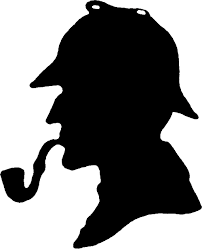
Background
Is it possible to develop observational abilities comparable to Sherlock Holmes?
Sir Arthur Conan Doyle’s fictional detective has many enviable skills, including mastery of disguise and some expertise at unarmed combat, as well as generally being a genius, but we will focus primarily on his more well known observational power. Though Holmes is often described as a master of logical “deduction,” this power is better described as (possibly superhuman) abduction. That is, Holmes perceives tiny details that many people would miss, then constructs explanations for those details. By reasoning through the interacting implications of these explanations, he is able to make inferences that seem impossible to those around him. The final step is actually deductive, but the first two are perhaps more interesting. Holmes’ ability to perceive more than others does seem somewhat realistic; it is always possible to actively improve one’s situational awareness, at least on a short term basis, simply by focusing on one’s surroundings. The trick seems to be the second step, where Holmes is able to work backwards from cause to effect, often leveraging slightly obscure knowledge about a wide variety of topics.
I spent several of my naive teenage years trying to become more like Holmes. I carefully examined people’s shoes (often I actually requested that the shoes be handed over) for numerous features: mud and dirt from walking outside, the apparent price of the shoe, the level of wear and tear, and more specifically the distribution of wear between heel and toe (hoping to distinguish sprinters and joggers), etc. I “read palms,” studying the subtle variations between biking and weightlifting calluses. I looked for ink stains and such on sleeves (this works better in fiction than reality). I’m pretty sure I even smelled people.
None of this worked particularly well. I did come up with some impressive seeming “deductions,” but I made so many mistakes that these may have been entirely chance.
There were various obstacles. First, it is time consuming and slightly awkward to stare at everyone you meet from head to toe. I think there are real tradeoffs here; you have only so much total attention, and by spending more on observing your surroundings, you have less left over to think. Certainly it is not possible to read a textbook at the same time, so practicing your observational techniques comes at a cost. Perhaps it becomes more habitual and easier over time, but I am not convinced it ever comes for free.
Second, the reliability of inferences decays quickly with the number of steps involved. Many of Holmes’ most impressive “deductions” come from combining his projected explanations for several details into one cohesive story (perhaps using some of them to rule out alternative explanations for the others) and drawing highly non-obvious, shocking conclusions from this story. In practice, one of the explanations is usually wrong, the entire story is base on false premises, and the conclusions are only shockingly wrong.
Finally, correctly constructing explanations for small details of another person’s appearance usually requires shared life experience and context. You might recognize a pin on their backpacking as referencing a particular fandom (how else, but by watching the same show yourself?). You might identify the shoes clipped to that backpack as for climbing (how else, but by going climbing yourself at least once?). You might recognize their accent as Midwestern (how else, but having friends of acquaintances from the Midwest?). So it seems that becoming like Holmes may require accumulating more life experience than others: exploring instead of exploiting, switching careers often, spending time in many different social strata, playing many different sports, rotating your musical and entertainment choices constantly, etc. Perhaps also traveling and living in many different places, though it is perhaps notable that even Holmes confines himself to deep knowledge of life in London. The problem with this strategy is that it is not clearly possible to increase one’s life experience far beyond the norm (at least, for one’s age group; and it seems that older people run some risk of lacking shared context with younger people). Life experience is somewhat limited bandwidth. I do not believe it is like electrical engineering, where one can learn drastically more about it by reading many textbooks and building circuits instead of passively absorbing basic facts about how the outlets on the wall work and what an HDMI cable is from life experience. You cannot really learn what a climbing shoe looks like by reading (non-picture) books (though @jenn has claimed that reading autobiographies specifically has helped her make some surprising observations). And though it is in principle possible to watch many, many more popular shows than an ordinary person, you cannot watch all of them, and it is basically not worth the time. Also, you’d probably be cluttering your mind with largely useless knowledge. Or as Holmes says (thanks to @Shankar Sivarajan for the reference):
“I consider that a man’s brain originally is like a little empty attic, and you have to stock it with such furniture as you choose. A fool takes in all the lumber of every sort that he comes across, so that the knowledge which might be useful to him gets crowded out, or at best is jumbled up with a lot of other things, so that he has difficulty laying his hands upon it. Now the skillful workman is very careful indeed as to what he takes into his brain-attic. He will have nothing but the tools which may help him in doing his work, but of these he has a large assortment, and all in the most perfect order. It is a mistake to think that that little room has elastic walls and can distend to any extent. Depend upon it there comes a time when for every addition of knowledge you forget something that you knew before. It is of the highest importance, therefore, not to have useless facts elbowing out the useful ones.”
-Sir Arthur Conan Doyle, A Study in Scarlet
It is this final problem that I hope to address here, by collecting in one place many observable details that indicate useful (or at least impressive sounding) information about others (the explanations).
Design Principles
As increasingly many people contribute suggested entries, I have had to curate the list’s content. In particular, the list would be become useless if it attempted to include the meaning of every conceivable symbol or a the origins of every clothing item—in the limit, nearly everything on the internet is probably distantly useful for some kind of inference.
My guiding principle when judging what to include is Shannon’s information theory. The most valuable entries apply to ~50% of people because this guarantees you get to use them a lot (even when the entry doesn’t apply, that tells you something surprising as well). Technically, this maximizes the entropy of the signal. Since creating the list, I have also had many opportunities to attempt abductions. At the time of writing, it is still the case that not a single entry applies to many people, (arguably) underscoring the need to focus on frequently occurring details rather than ones that tell you a lot when they do occur. It is pretty rare that I consciously notice a detail that seems “interesting” but isn’t on the list, so it may be hard to find many more ~50% likely entries—on the other hand, it is very possible that my mind dismisses many details I don’t know how to use.
The secondary principle is reliability. I try not to add any entries that seem likely to have alternative explanations, even if I do not have an alternative explanation in mind. Feedback from commenters has been helpful here when I slip up (and made me even more cautious about this).
For the fiendishly committed, resources providing hints that seem too unreliable or too low entropy to belong in the list itself are linked and suggested throughout (and will likely be collected as “further reading” in the future).
Rules
Please add your contributions in the comments. Alternatively, you can email me entries directly at colewyeth@gmail.com. If you’re interested in seeing updates / related discussion, you can also ask to join the google group (sherlockian-abduction@googlegroups.com) - either by emailing me or finding it in groups. I don’t expect to post there more than once or twice a month.
I will impose some basic requirements for what is promoted from the comment section to the post to maintain epistemic rigor and usefulness.
Rule 1: Do not post useless trivia or anything which is likely to become irrelevant in one year (pop culture, fandom symbols, etc.) unless there is a very compelling reason. Generally if it is not worth memorizing the top 10 examples of the general class that the observation/explanation comes from, do not post it. I am not interested in fandom symbols or transient fashion trends. I am interested in common religious symbology/garb and signs of athletic activities, particularly when those athletic activities imply applicable abilities (like competence in a fight or unusual speed on land or in water).
Rule 2: I will not promote anything unless I am reasonably confident it works. Either you should have used it yourself in at least a handful of cases (without a significant fraction of false positives) or you should link highly reliable sources that observation → explanation. In either case, I will generally require at least one other commenter (possibly myself) to confirm that they have successfully applied the inference in real life. If something is particularly interesting, but I am not confident it is true, I will add it with the label [SPECULATIVE].
The List
The list is organized head to toe, as one might scan a person.
Linguistic cues are listed last, both because they are likely to be encountered last, and because I think they are less worth memorizing. There are simply too many regional accents to keep track of; I’ll try to focus on cues with high surprisal.
Rastacap → Rasta = Adherent of Rastafari(anism)
Source: Me (Cole Wyeth)
Confidence: Mid-High
Relevant Background: https://en.wikipedia.org/wiki/Rastafari
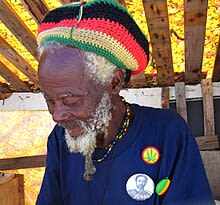
Rastifari is a complex philosophy / religion /movement. Briefly, it can be viewed as an Afrocentric sect of Christianity. The colors originate from the Ethiopian flag with the addition of Black (referencing the skin color). I’ve seen this pattern on various objects (such as scarves), not just the cap. Rasta also tend to wear dreads. Anecdotally, there’s a chance that someone might wear these patterns to indicate marijuana use/affinity (which is pretty central to the customs of this group) rather than actual religious adherence.
Prayer Callous → Devout Muslim
Source: @BasilLabib
Confidence: Mid-High
Relevant background: https://en.wikipedia.org/wiki/Prayer_callus

According to Basil:
It’s the prayer callus (Arabic: zebiba) observed on the forehead of very devout Muslim believers. As Muslims are obligated to pray five times a day and they prostrate on the ground (the sadjah), this mark is a definitive sign of the piety of the person and their adherence to the Islamic faith. Fun fact: The mark is also mentioned as an identification mark in the Holy Quran (48:29).
This seems like a reliable sign, though I can’t rule out the possibility of other religious traditions causing a similar prayer callus.
Cauliflower Ear → Combat Sports
Source: Me (Cole Wyeth)
Confidence: High
Relevant background: https://www.nationwidechildrens.org/conditions/cauliflower-ear
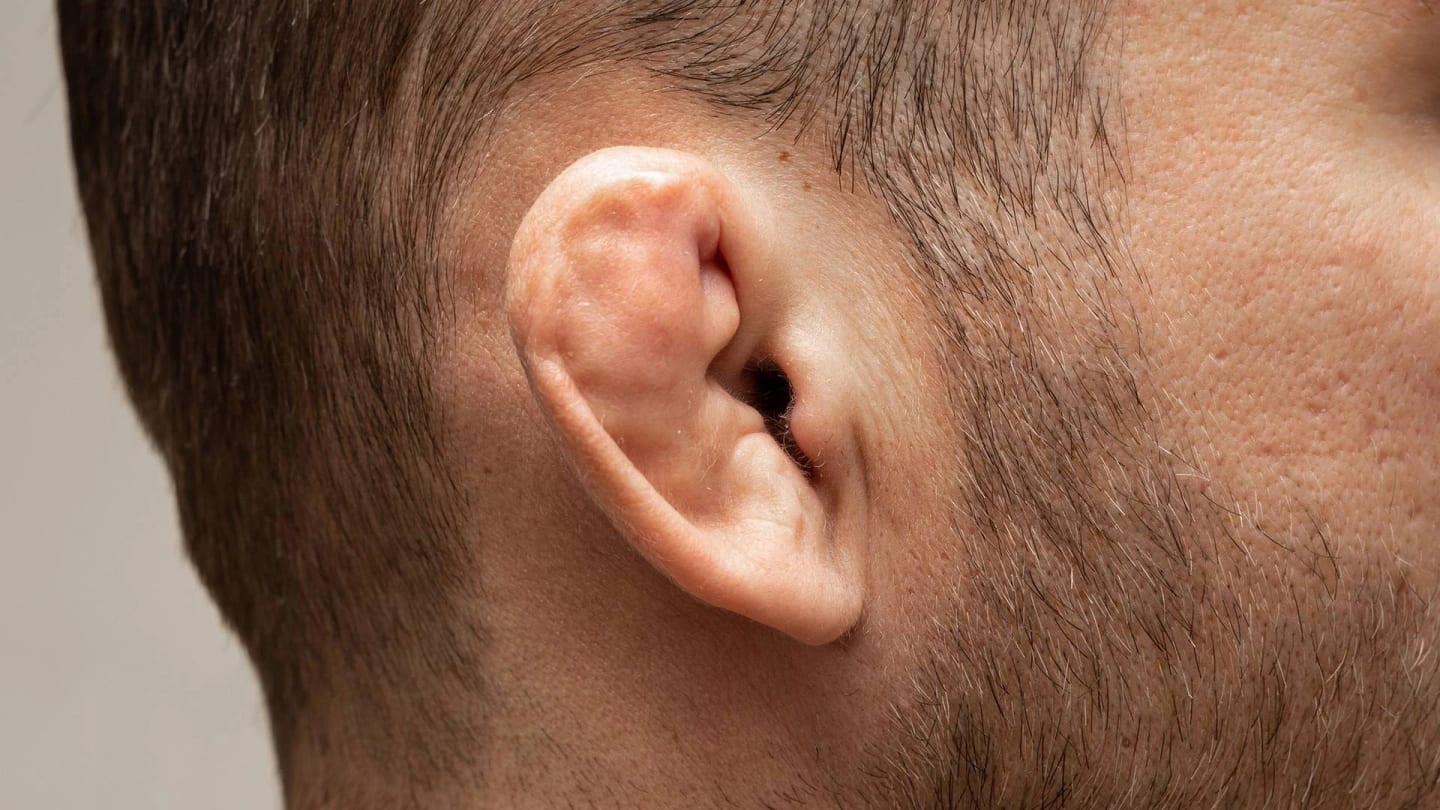
I trained MMA and particularly Brazilian Jiu Jitsu for many years. I encountered many people with cauliflower ear, usually former wrestlers or cage fighters. I believe it is common in boxers as well. I do not remember ever encountering anyone with cauliflower ear who did not have a history in combat sports of some variety (a nontrivial observation because I ran frequent intro classes with people who had no martial arts background, as well as many who did). I understand that this is usually a result of repeated trauma to the ear, and though serious swelling usually recedes, after enough instances the ear never really regains it original shape. It has been observed in these circles (slightly tongue-in-cheek) that if you see someone on the street with cauliflower ear, you probably shouldn’t mess with them. It is of course also possible that some people have suffered blows to the ear for some other reason, or (if only one ear looks like this) perhaps one very traumatic blow, but I have never observed this.
Alternative explanations: @DAPuckett apparently has cauliflower ear from cold exposure.
Ash on Forehead → Christian (perhaps Catholic)
Source: Me (Cole Wyeth)
Confidence: High
Relevant background: https://en.wikipedia.org/wiki/Ash_Wednesday

Various Christian denominations observe “Ash Wednesday” which includes smudging ash on their foreheads in the shape of a cross (the cross may not always be easy to make out). This tends to be accompanied by fasting, Lenten sacrifices, abstinence etc. - the details will depend on denomination.
Scope Bite → Firing a Gun with a Scope
Source: Me (Cole Wyeth) with background from my brother (Ames Wyeth)
Confidence: Low-Mid
Relevant background: https://www.wingtactical.com/blog/how-to-prevent-scope-bite/
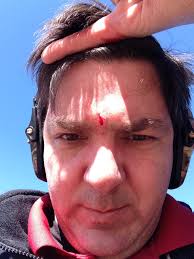
This happened to me, but I received generalized bruising (around the nose where my safety glasses rested) instead of a cut. Though this obviously implies there is some variance in the wounds, most images online look pretty similar and highly characteristic.
I saw a guy in an airport (pretty much a random sample) with a cut on his forehead and guessed it was scope bite, but it turned out to be from a car accident. To be fair, there was a little bruising elsewhere and it was too high, so it didn’t actually match this entry—but this still caused me to lower the confidence because on base rates most cuts are not from scope bite.
Bruising coming from the upper eyelid → Blepharoplasty postoperatory
Source: A doctor friend of an anonymous user who was exposed to this operation
Confidence: Mid-High
Relevant Background: https://www.nhs.uk/tests-and-treatments/cosmetic-procedures/cosmetic-surgery/eyelid-surgery/
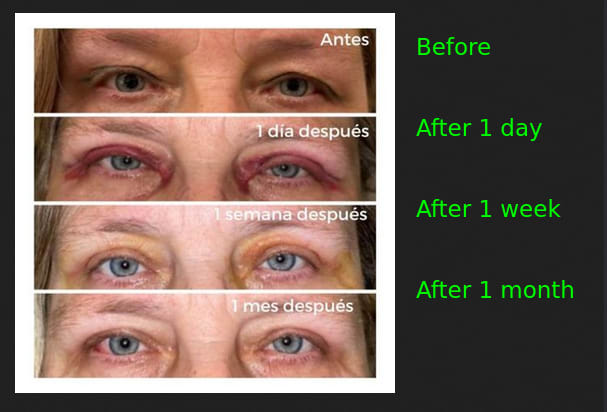
This type of surgery leaves bruises on the eyes as if you had been punched twice, once in each eye. This probably varies because everyone heals differently.
The effects of this operation seem to last ~ 1 month.
So if you see marks from this, it is because the operation was done a few days or weeks ago. This isn’t just an aesthetic operation but a life quality operation because some people can see well because the upper eyelid can block your vision!
It seems that this operation can be focused on aesthetics and/or quality of life. I have never tried this in real life but it seems quite plausible.
Broken Capillaries on Face → Drug or Alcohol Use
Source: Me (Cole Wyeth)
Confidence: Low [SPECULATIVE]
Background: For various potential causes, see https://www.medicalnewstoday.com/articles/321387#treatment. For various skin problems caused by drug and alcohol use, see https://www.sciencedirect.com/science/article/abs/pii/S0738081X21000699?via%3Dihub
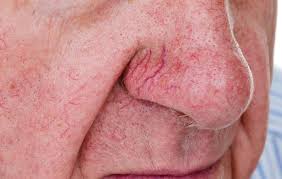
It is not guaranteed that the above image shows a result of alcohol. In general, causality seems hard to verify (though it seems consistent with my experience). which is why this remains speculative.
Collapsed Nose → Cocaine Addict
Source: Ames Wyeth
Confidence: Mid-High
Background: https://www.thehopehouse.com/cocaine-addiction/related/cocaine-nose/

Though I’ve generally tried to include usable real-life photos for each entry, pictures of this condition are too graphic. In less extreme cases, cocaine use can cause nosebleeds and sniffling.
Teardrop tattoo → May have been a Prisoner
Source: @jenn
Confidence: Low [SPECULATIVE]
Background: https://en.wikipedia.org/wiki/Teardrop_tattoo
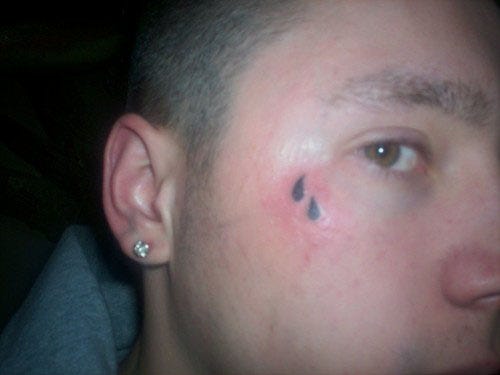
According to @jenn :
teardrop tattoo right under the eye: this person killed someone or was in prison at some point, or want to pretend that that’s true for them (e.g. if they’re a soundcloud rapper from the suburbs). also see other prison tattoos
However, this tattoo seems to have various possible meanings—if you’re interested dig into some of the links (insert most common trigger warnings), either way don’t jump to conclusions.
Sun Damage on One Side of Face → Trucker
Source: SeñorDingDong
Confidence: Mid
Relevant background: https://www.cbsnews.com/news/trucker-accumulates-skin-damage-on-left-side-of-his-face-after-28-years-on-the-road/
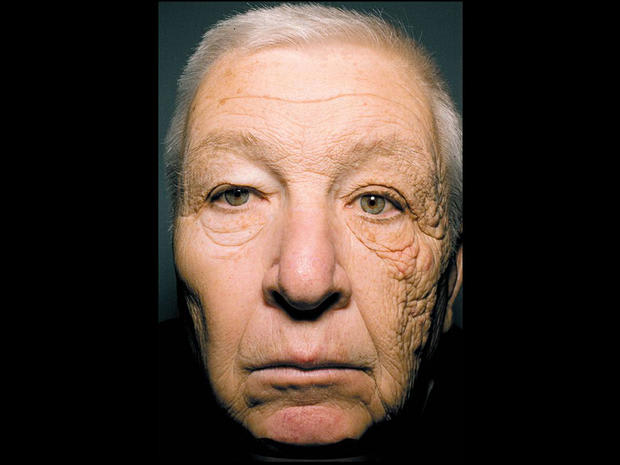
The image is from an actual long-time trucker. In a minor case, you might see sunburns or tanning on one side of the face (the closer window side, so perhaps you can also determine what side of the road they drive on indicating geographic location).
Marks on Neck and Chest → Violinist
Source: Ana
Confidence: Mid-High

Obviously, this should be interpreted that these specific marks imply someone might be a violinist. This has been confirmed by my friend Gennie (who says it’s only likely to show up from intense practice or if you have delicate skin) and my friend Bella, who says that the position varies (she has one close to the one on the jaw in the picture but not the lower ones because she “had a good shoulder rest and didn’t play baroque style”).
Alternative explanations: Apparently cold can cause skin reactions too, though I have some doubts it would cause these precise patterns.
Closing Pin Necklace → Skydiver
Source: @Eli_
Confidence: Mid-High
Background: https://www.dropzone.com/forums/topic/34565-how-do-you-use-your-closing-pin-necklace%3F/
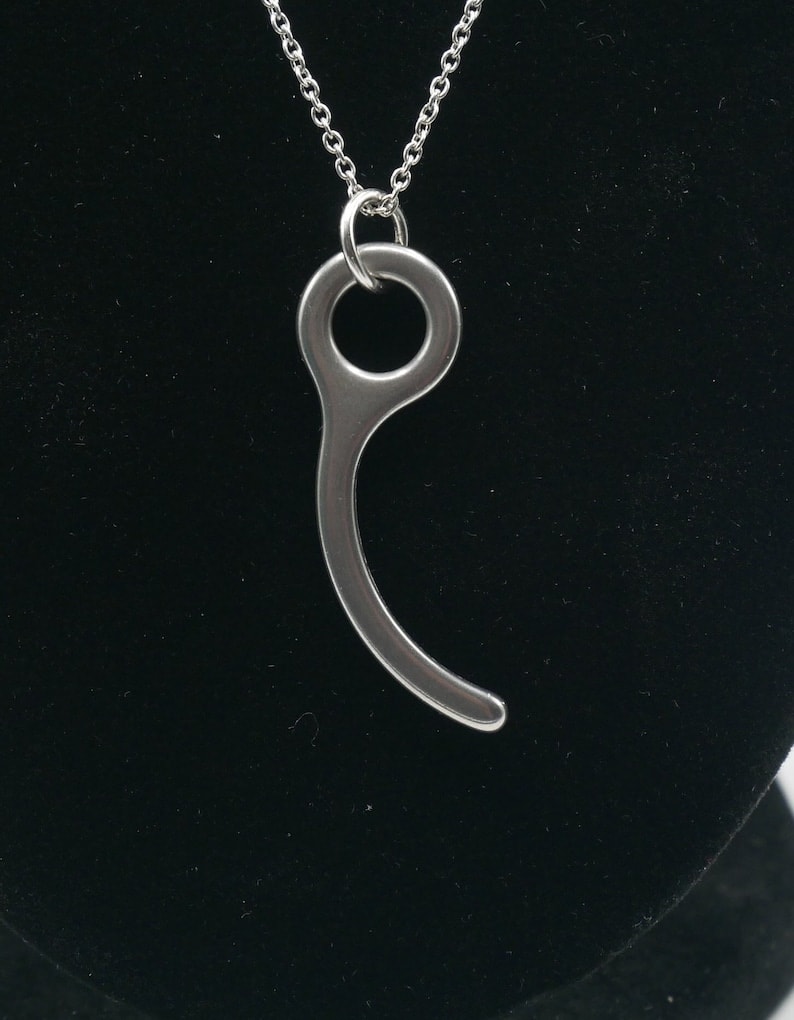
Apparently skydiver’s (semi)regularly identify each other this way. Also they refer to non-skydivers as “whuffos”.
Collar/key Necklace → BDSM
Source: Saira
Confidence: Mid
Background: https://www.etsy.com/ca/market/key_slave_collar (presumably the content shifts a lot since this is just a link to etsy)
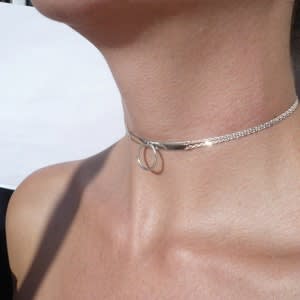
There are lots of fancy little key/lock necklaces that probably have nothing to do with this, but there seem to be particular types that indicate membership in the BDSM subculture. I am really not qualified to go into detail here, but it looks like the “lock” necklaces and anklets often have a little ring like this (the one in the photo is a more subtle example, some look.. draconian). I believe this is because they are not removable without the key, with both ends attached to the loop. The keys seem to usually be a specialized cylindrical tool not an ordinary key—so if you see someone with a fancy ornate key it’s probably for something else. Would appreciate mechanical and interpretive details from anyone in the know, but will probably leave them in the comments to keep the list itself reasonably SFW.
Lambda Symbol → Lesbian
Source: One of my lesbian moms
Confidence: Mid-High
Relevant Background: https://www.cs.cmu.edu/afs/cs/user/scotts/ftp/bulgarians/lambda.html
Also appears along with various other queer symbols at https://www.dmu.ac.uk/events/pride/symbols.aspx
When used to represent lesbian identity, the lambda symbol usually seems to be used in combination with a pink or rainbow color scheme.
Crucifix Necklace → Perhaps Orthodox Christian
Source: Casey
Confidence: Low-Mid
Relevant Background: https://en.wikipedia.org/wiki/Crucifix

From Wikipedia:
The crucifix is a principal symbol for many groups of Christians, and one of the most common forms of the Crucifixion in the arts. It is especially important in the Catholic Church, and is also used in the Lutheran Churches, Anglican Churches, Eastern Orthodox Church, and in most Oriental Orthodox Churches (except the Armenian Church and Syriac Church).[3][4][5] The symbol is less common in churches of other Protestant denominations, and in the Assyrian Church of the East and Armenian Apostolic Church, which prefer to use a cross without the figure of Jesus (the corpus).[6][7]
According to Casey, the crucifix is generally more common in Orthodox branches of Christianity. This seems to be born out by the above quote. Of course, an ordinary cross without the emaciated Jesus is sort of the standard choice for Christians (at least everywhere I have traveled).
I also recommend looking into the various types of prayer beads—among Christians, the most common type seems to be the Catholic rosary, but there are others. Also, prayer beads are used in several other religions (notably, they are not common in Judaism), and the types seem fairly straightforward to distinguish in many cases. This deserves to be divided up into its own sections eventually.
Circular Bruising → Cupping
Source: Novy
Confidence: High
Relevant Background: https://my.clevelandclinic.org/health/treatments/16554-cupping
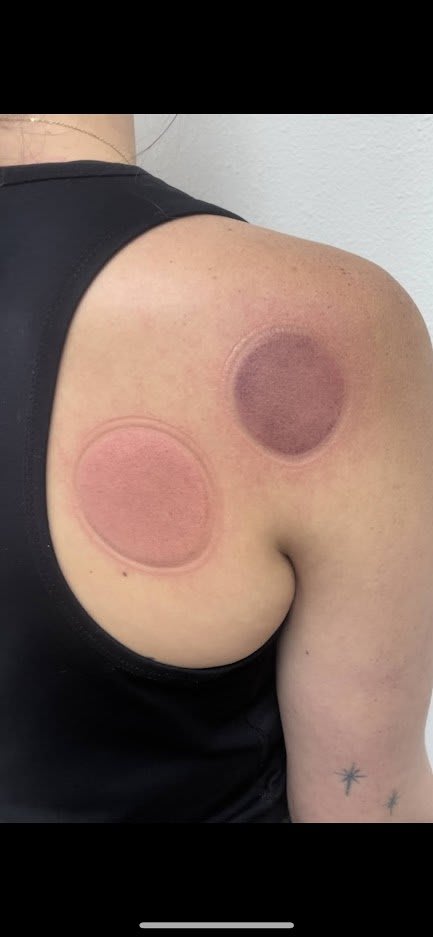
According to Novy:
Athletes, celebrities, and people interested in “natural health” may sometimes receive cupping treatments, in which a warm glass cup is placed on the skin, usually around the back or neck. As the cup cools, a vacuum is created within the cup drawing the skin up into it. This creates a very distinctive, circular, red welt. Seeing these marks almost guarantees that the person received a cupping treatment. You could reasonably expect that the person with the cupping marks is either an athlete or engages in some kind of massage or similar “self-care” service, possibly that they think this process will help draw toxins from their body.
Bonus points if anyone can identify the tattoos on this woman’s arm—a variation on the crucifix?
Ribbon Pin → Raising Awareness
Source: Me (Cole Wyeth)
Confidence: Mid-High
Relevant Background: For classifications by color (~impossible to memorize but might be applied retrospectively) see https://www.thepinpeople.com/custom-products/awareness-ribbon-pins/custom-awareness-ribbon-pin-colors-and-awareness-ribbon-meanings/.
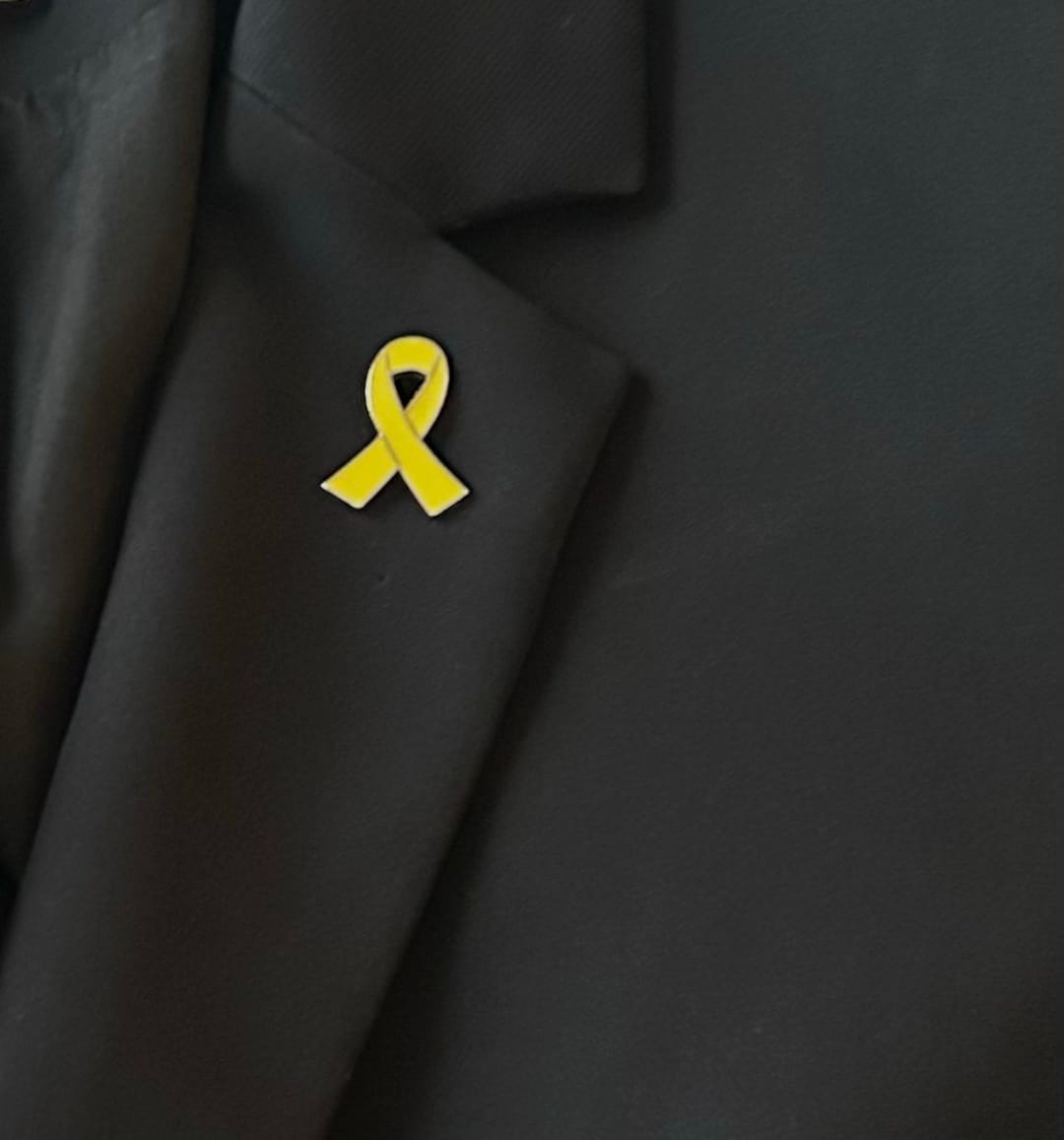
This symbol has been used to raise awareness for many causes from politics to medicine. I was inspired to add it to the list after observing a yellow ribbon pin on a conference speaker’s shirt. I was actively looking for details that stood out, but I did not yet know how to use (to estimate the effective upper limit on the number of rules that might apply to the average person). At the end of his talk he presented a slide calling for the release/rescue of Israeli hostages in the Gaza strip (using the yellow ribbon symbol) so in principle I may have anticipated this with a more exhaustive list!
Red Poppy Pin → Support for Veterans
Source: Me (Cole Wyeth)
Confidence: High
Relevant Background: https://en.wikipedia.org/wiki/Remembrance_poppy, https://www.legion.ca/remembrance/the-poppy
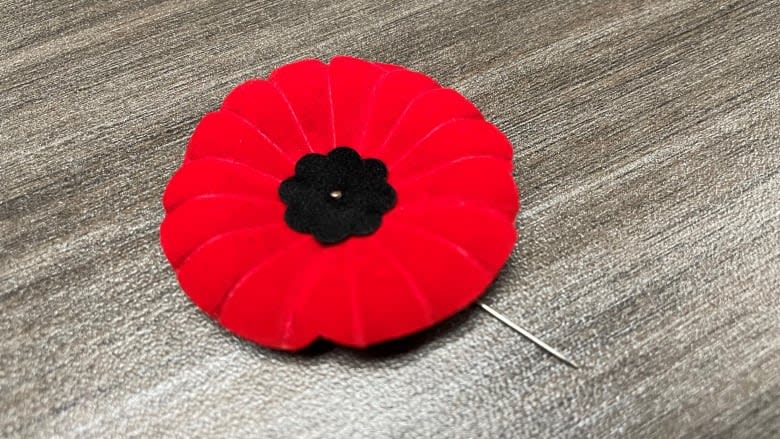

I see these very frequently around Remembrance Day in Canada, but apparently its not unique to us (it’s mostly particular to Commonwealth nations). Fortunately, the poppies look different in different countries! The top picture is a Canadian poppy, which is also visible in the second picture beneath a Scottish poppy. Other colors also have meanings, for instance white is for peace, purple for animal casualties. Take a look at the first link for details, there is too much for me to repeat or memorize.
Pinneapple Symbol → Swinger
Source: Saira
Confidence: Mid-High
Relevant Background: https://www.cruisecritic.com/articles/upside-down-pineapple-cruise-ships
A pinneapple can also signify hospitality, but particularly if its upside-down or accompanied with other hints, it’s very likely an indication of swinging (consensual non-monogamy).
Patches on Cut-Off Vest → In a Motorcycle Club
Source: Ames Wyeth
Confidence: High
Relevant Background: https://en.wikipedia.org/wiki/Colors_(motorcycling), see also https://en.wikipedia.org/wiki/Outlaw_motorcycle_club
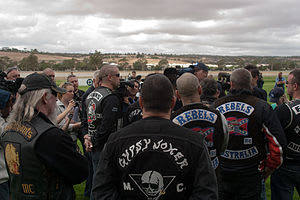
The first source describes an extensive amount of information that can be read from a biker’s “kutte.” I would be more confident in the details with some first-hand confirmation, but sources seem to agree on the basics. Note that not all motorcycle clubs are outlaw (this is indicated by a “1%” patch) and even the “outlaw” clubs might only be violating motorcycle club regulations and not real laws.
Continuous Glucose Monitor → Diabetic
Source: SeñorDingDong
Confidence: High
Relevant Background: https://en.wikipedia.org/wiki/Continuous_glucose_monitor

These small white patches are pretty hard to miss unless covered by sleeves. I guess there is a chance of confusing them with other patches (for instance nicotine patches for e.g. quitting tobacco / replacing cigarettes—I would add an entry for this, but it looks exactly like a birth control patch to me). However, CGM’s are much bulkier since they are an electronic device. Please let me know if there are any other common devices that look like a CGM.
Semicolon Tattoos → Faced/Faces Mental Health Challenges
Source: @jenn
Confidence: High
Relevant background: https://en.wikipedia.org/wiki/Project_Semicolon
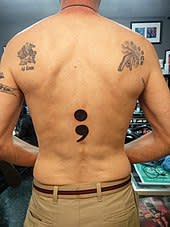
indicates that someone is struggling with or has overcome severe mental health challenges such as suicidal depression. You see them fairly often if you look for them. i’ve heard that butterflies and a few other tattoos mean similar things, but you’ll run into false positives with any more generic tattoos.
-Jenn
I have also observed this in real life.
Scar on Inside of Elbow → Blood Donor (or addict)
Source: A lab tech I talked to
Confidence: Mid-High
Relevant Background: https://www.reddit.com/r/Blooddonors/comments/16zcj4q/questions_about_scarring/
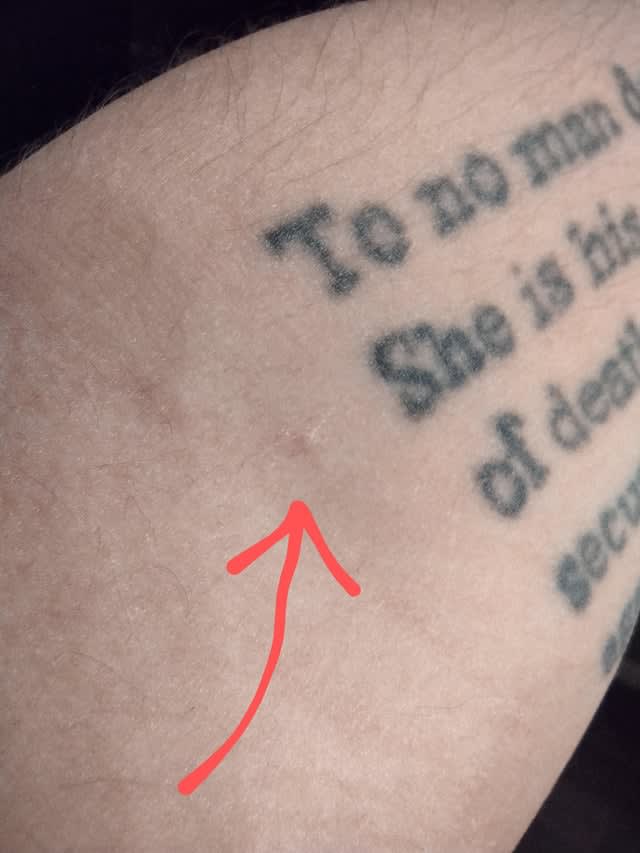
The lab tech I discussed this with described the scarring as “half moon.” Most of the pictures I can find seem to have scars located on the crook of the elbow specifically, which makes sense.
Puzzle Piece Tattoo → Supports Autism Awareness
Source: @jenn
Confidence level: Mid
Background: https://www.reddit.com/r/autism/comments/tcj5ak/question_about_puzzle_piece_tattoo/
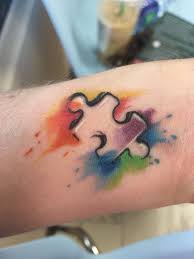
puzzle piece tattoo or jewelry: this person likely has an autistic child or close family member, and is not super up to date on the most uh, progressive thoughts on the topic. autistic people themselves are more likely to dislike the puzzle piece symbolism for autism
I have observed this tattoo in real life, but did not have a chance to confirm the meaning was as expected. Though it is well documented that this was once a symbol for autism, I have no reason to believe there are NOT other likely interpretations and would appreciate confirmation in the comments.
Rainbow Infinity Tattoo → Autistic (or possibly supports autism awareness)
Source: Ana
Confidence: Mid
Background: https://infinitycenteraba.org/the-infinity-symbol/
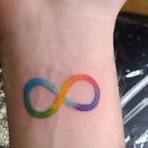
Apparently the rainbow colored infinity symbol is a more modern symbol than the puzzle piece, viewed as embracing diversity of experience without implying something is missing. As usual, the confidence would be higher if I knew there weren’t other meanings, so please pitch in if you’ve seen this symbol used to represent something else.
Neda Tattoo → Eating Disorder Recovery
Source: A friend
Confidence: Mid-High
Background: https://lisettehoschek.com/2022/11/15/eating-disorder-recovery-tattoo-why-its-so-helpful/
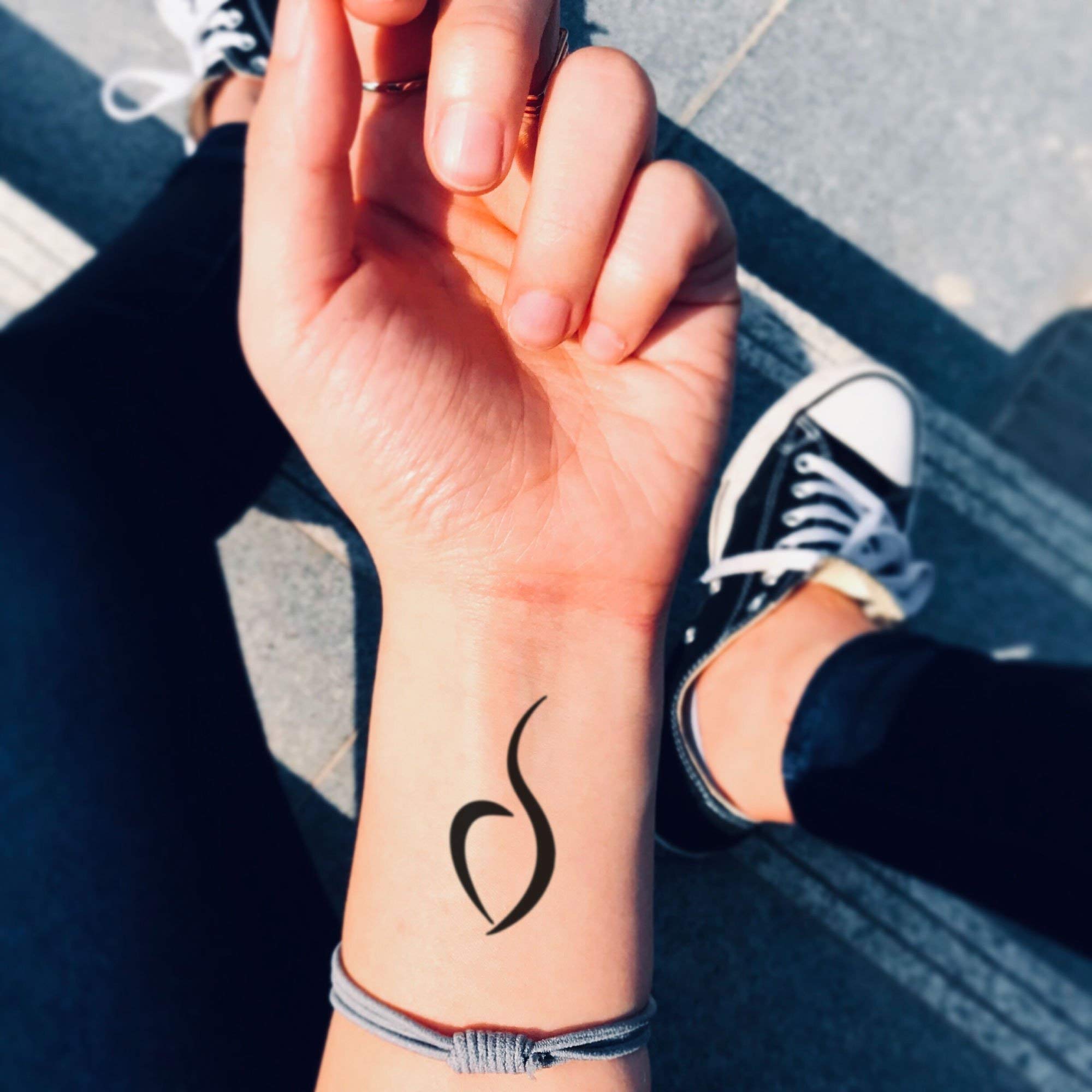
This tattoo is literally NEDA’s logo, so pretty confidently means this person has struggled with an eating disorder (or someone close to them has). Other elements may be incorporated into the tattoo.
Forearm bruising → Archery
Source: nicbeans311
Confidence: Mid
Background: https://archery360.com/2019/10/30/how-to-not-hit-your-forearm-with-the-bowstring/
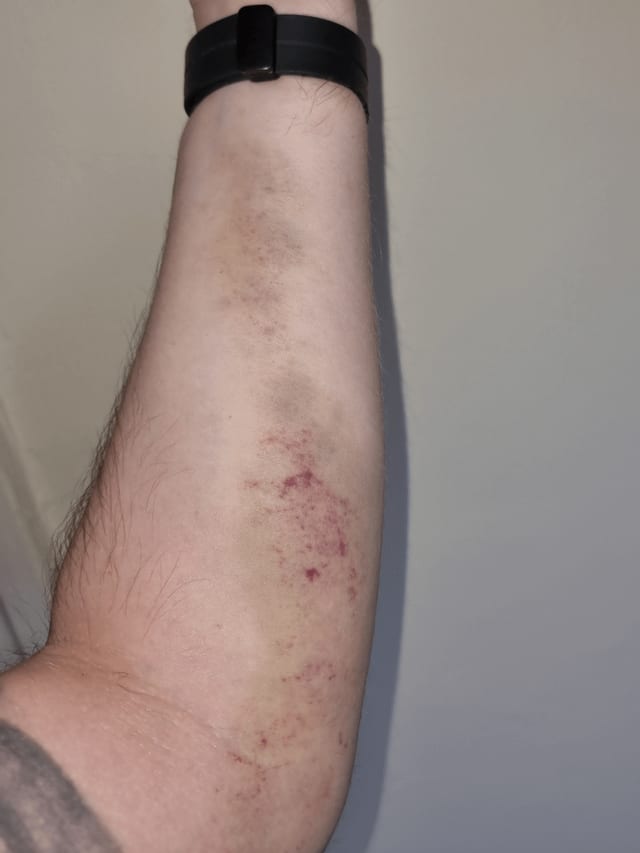
firing certain weapons can leave marks on a person’s hand. from slide bite from glocks to garand thumb from the m1 garand. there are also forearm marks from archery if you’re not wearing an arm guard.
a person also walks differently when wearing a weapon, their arm usually accommodates the space. a leather belt can show wear in the area where a badge might be repetitively attached and detached.
Though proper form can prevent this, apparently the string of a recurve bow will still bounce around an leave a red mark if no armguard is used.
Inconsistent Cuts and Burns on Wrists and Hands - > Chef/Cook
Source: My barber
Confidence: Low [SPECULATIVE]
Background: More than you wanted to know https://heavytable.com/battle-wounds-kitchen/
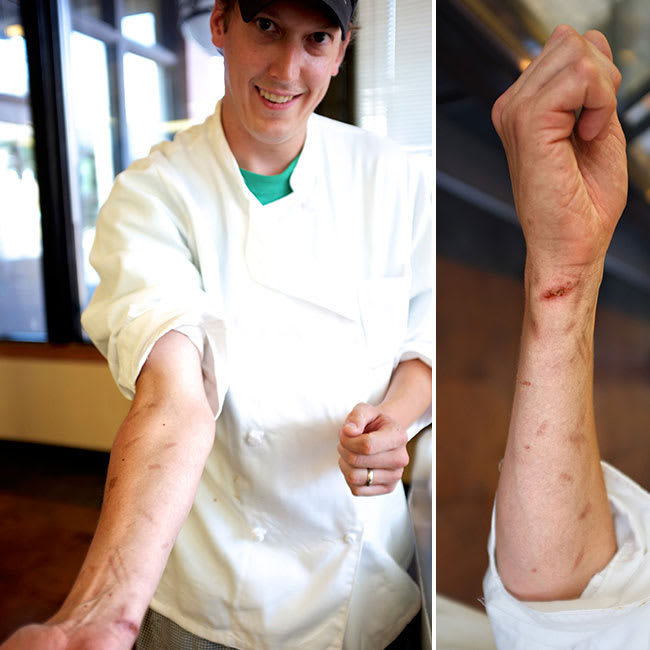
These should be distinguished from cutting scars (deliberately self-inflicted wounds which tend to be longer and at consistent angles) and cuts on fingers which are common for barbers (I tested this once in the real world, but only to discover that the cashier at a barber shop was also a barber in training which to be fair is not surprising).
Persistent Cut or Scar on Knuckles (Russell’s Sign) → Bulimia Nervosa or Anorexia Nervosa
Source: @rationalelf
Confidence: Mid
Relevant background: https://en.wikipedia.org/wiki/Russell%27s_sign
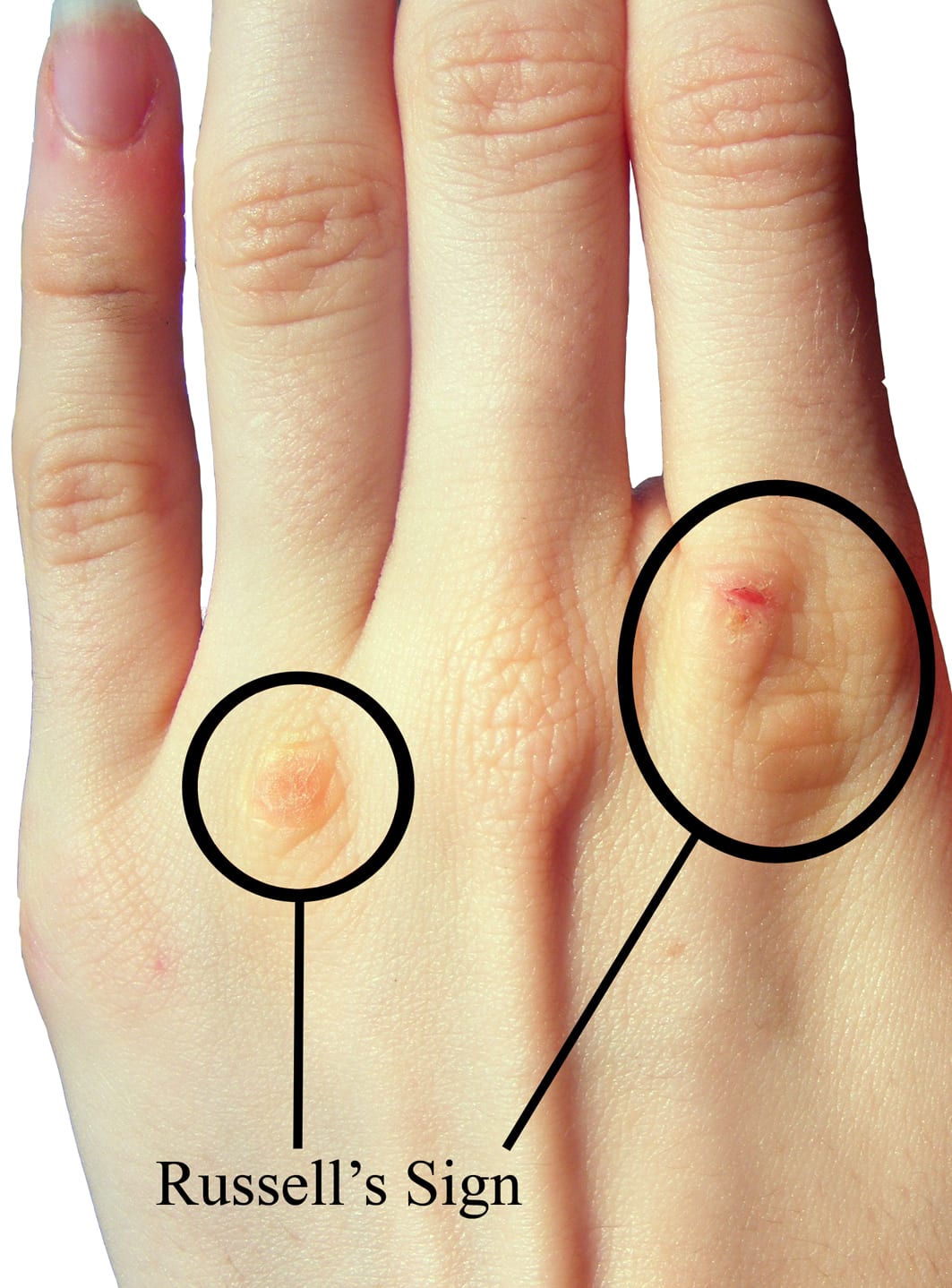
This scarring can result from using a finger to induce vomiting, so is a sign of an eating disorder. Obviously, knuckle scarring could also be a sign of e.g. boxing, but in that case is likely to occur on both hands.
The sign won’t always appear; from Wikipedia:
Bulimics who are capable of “handsfree purging”, or the induction of vomiting by the willful opening of the esophageal sphincter in a manner similar to belching, while contracting the stomach muscles, do not have Russell’s sign.
Thumb Callus/Bruise → Weightlifting (Hook Grip)
Source: @hotpomm
Confidence: Low
Background: https://www.reddit.com/r/weightroom/comments/nalmj/does_anyone_else_get_this_from_hook_grip/, https://www.catalystathletics.com/article/2167/The-Hook-Grip-Why-How-to-Do-It-Correctly/
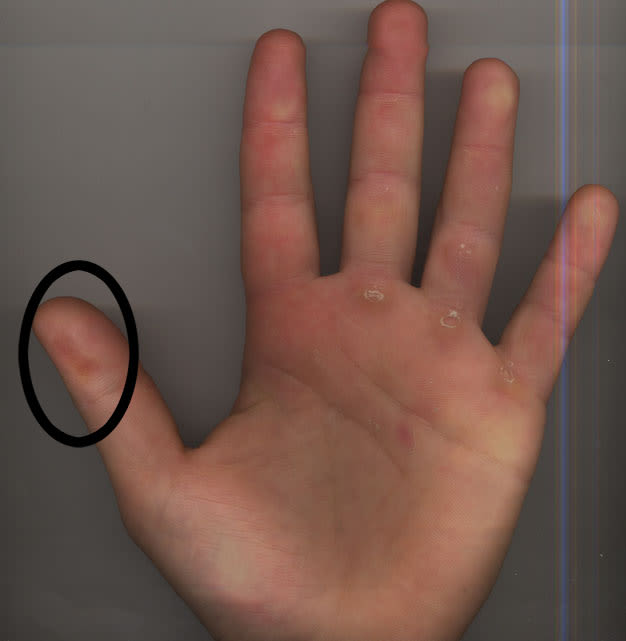
According to hotpomm:
...Additionally if there are some callouses on the thumb that can indicate that they do olympic weightlifting meaning snatch and clean and jerk because there everybody uses a hook grip where the thumg is squeezed on to the bar by the other fingers to increase grip strength.
Notice that there are also calluses on the (inside) knuckle joint of the palm (sorry, don’t know the correct anatomical name) and the fingers near the base. These signs are not as reliable for weightlifting specifically—I’ve also seen them occur from biking and climbing.
Somewhat validating my skepticism, I tried to use this in real life and was wrong. The woman did some manual labor but not weightlifting.
Mid-Hand Calluses → Weightlifting
Source: Me (Cole Wyeth)
Confidence: Low-Mid
Relevant Background: https://www.reddit.com/r/weightlifting/comments/mzyzdk/anyone_got_any_experience_with_these_calluses/
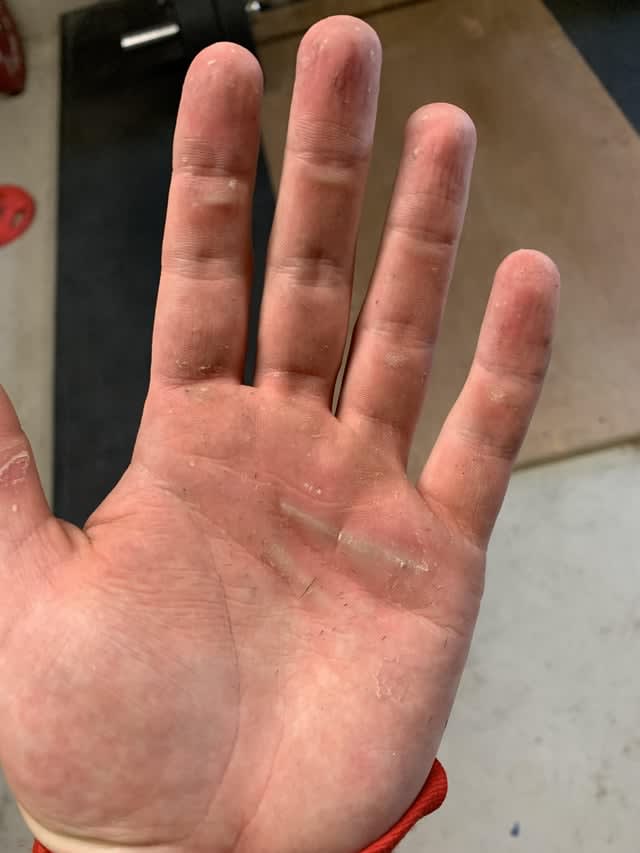
Though it’s generally difficult to classify calluses in practice (as noted in an above entry) I imagine that a clear line on the center of the hand like this is a pretty reliable indication of weightlifting.
Lower palm blister or bruise → (Active) Baseball player
Source: Casey
Confidence: Mid (not sure how to determine this objectively; not all baseball guys get this as it is conditioned on how you swing, how much you swing, whether you use batting gloves, and what bat you use)
Relevant Background:Anybody else get blood blisters on the lower part of the palm (from i think the knob of the bat)? If so any solutions? thanks. : r/Homeplate
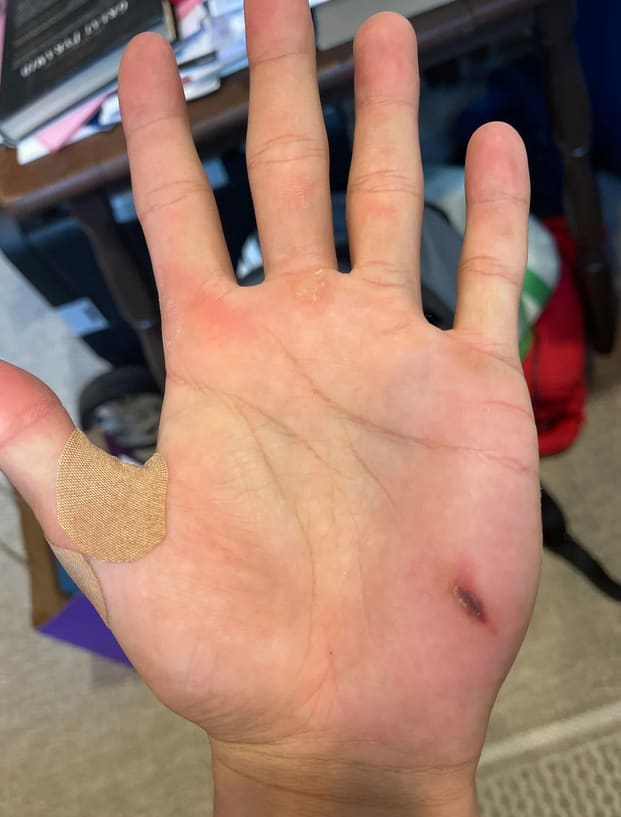
According to my friend Casey (who used to play a lot of baseball):
The constant swinging of a baseball bat can cause the knob of the bat to rub the palm. After hundreds of swings this can cause bruises and blood blisters. I had a teammate in college who would get a very large black blister in this area from swinging. I also personally would get a similar though less pronounced form of this blister.
Thick Hands and Fingers → Manual Labor
Source: Various
Confidence: Mid-High
Relevant Background: https://www.reddit.com/r/mildlyinteresting/comments/hmgqwl/my_dad_has_been_a_construction_worker_for_30/
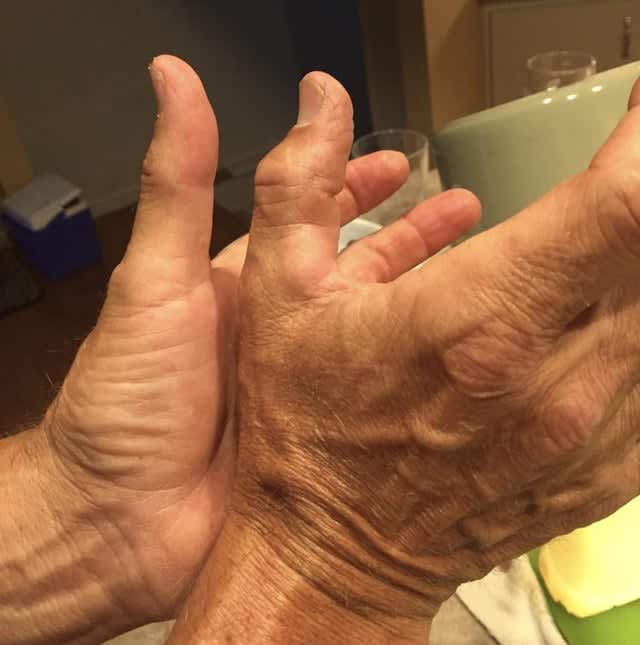
Apparently this is caused by micro-fractures in the bones of the hand from concussive blows (from e.g. hammering). One might imagine that some forms of exercise would have a similar effect, but I am not aware of any that do—for instance climbers have very strong fingers but this manifests mostly in enlarged wrists, not fingers or hands (the effect is muscular, not skeletal). As I understand it weightlifting develops various muscle groups and is usually not bottlenecked by grip strength; also most techniques I’m aware of seem unlikely to concussively damage the hands. Martial arts (particularly hitting heavy bags) tends to condition certain bones such as knuckles and shins, so I would anticipate that highly devoted practitioners of striking arts may possibly exhibit this effect. However, I don’t recall seeing this when I trained MMA, so there are far more manual laborers than sufficiently intense martial artists and manual labor should be an overwhelmingly likely explanation on base rates.
Cartier LOVE Bracelet → Wealthy Person in their Life
Source: Gennie
Confidence: Mid-High
Background: https://www.sothebys.com/en/the-cartier-love-bracelet-everything-you-need-to-know
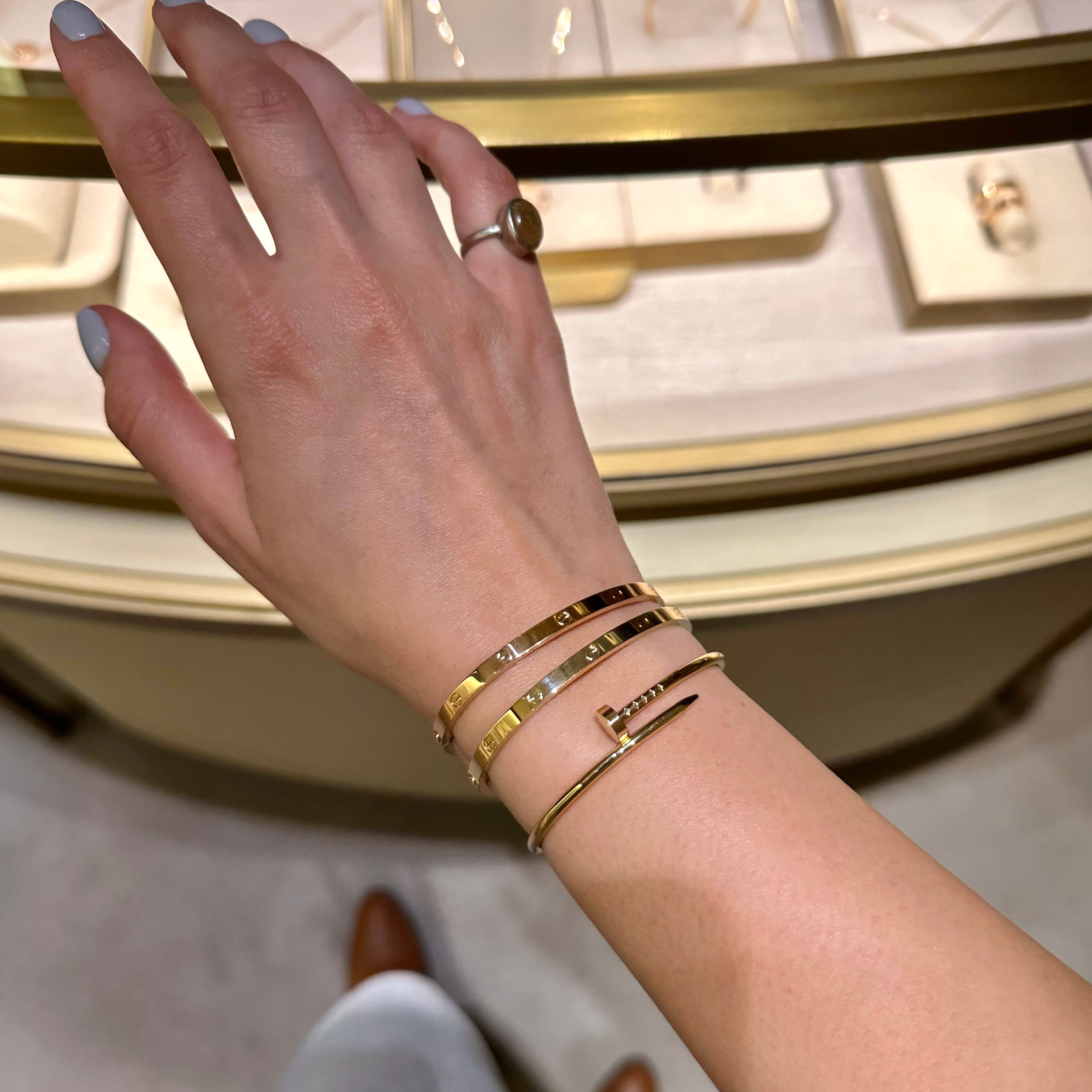
The top two bracelets are Cartier LOVE (the nail is also a Cartier motif). This collection is usually a gift from a loved one and runs in the thousands (the version with a diamond is in the tens of thousands). Since this usually comes as “permanent jewelry” and needs a special tool to attach and remove, someone who wears it probably doesn’t routinely do any physical activity that would damage it (e.g. rock climbing or manual labor, though they probably aren’t in the “manual labor” profession for obvious reasons).
I saw Cartier jewelry constantly visiting New York (and haven’t noticed it anywhere else). In one case I asked to make sure I was identifying it correctly, guessing that a random woman on the street was engaged. It turned out to be from her father, so technically the rule was probably correct but I did look silly (this is an acceptable sacrifice).
More generally, I suggest familiarizing yourself with the major brands of fine jewelry. These seem to remain relatively stable over time—you should be able to determine the designer with a closer examination (I think that an explicit brand name will typically appear but will be subtle), or at a glance if you’re familiar with the motif’s[1] of their collections. These seem too transient and low entropy to be worth memorizing for most people, but some basic knowledge of common motifs may be useful if you anticipate moving in upper class circles.
T Motif on Jewelry → Wealthy
Source: Gennie
Confidence: Low-Mid
The Tiffany T motif appears in various forms (google it or see the background link for an up-to-date list of offerings). This is a fine jewelry brand so will typically cost at least thousands. I have attempted to apply this entry once in real life, but I got it wrong, causing me to choose a low confidence (it was probably an imitation with a more ornate T, this motif always uses very straight lines though sometimes the two T’s fuse at the top and there may be embedded diamonds). For other common motifs, I recommend familiarizing yourself with the major brands of fine jewelry.
Band Ring on (Left?) Ring Finger → Married (see details)
Source: Me (Cole Wyeth) and Gennie
Confidence: High
Relevant Background: For location see https://www.diamondmansion.com/blog/wedding-ring-on-your-right-hand/, for materials see https://www.doamore.com/gold-vs-platinum-metal-for-your-ring/
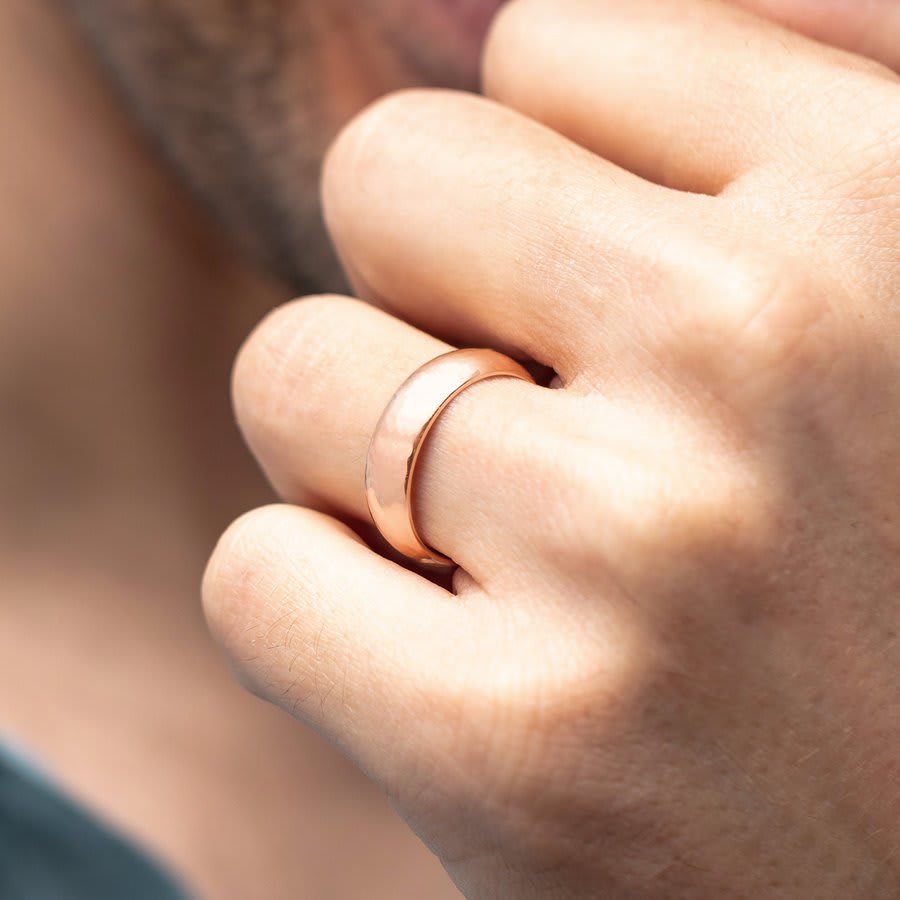
It is well-known that married couples wear a wedding band. In some countries (such as the U.S.) the wedding band is consistently worn on the left hand, but in others and some traditions the right hand is conventional (see the relevant background for a list—I am not sure which finger is used by country). Purer gold scratches more easily and is more expensive, and platinum scratches even more easily (but differently, apparently it forms a nice patina finish) and is even more expensive. Note that a wedding band is distinct from an engagement ring, which in my experience is usually slimmer with a diamond. It’s worth reading a lot about this entry because it occurs with very high frequency.
Claddagh Rings → Relationship Status
Source: @jenn
Confidence: Low [SPECULATIVE]
Relevant background: https://en.wikipedia.org/wiki/Claddagh_ring#Usage_and_symbolism
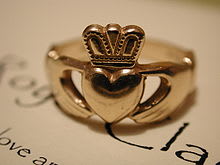
learned about this while jewelry shopping recently; it’s a ring that looks like a pair of hands holding a heart. it’s an irish thing, the finger you wear it on and whether or not it’s inverted indicates your relationship status.
Questioned by step17, causing me to lower the confidence level:
...I saw the claddagh ring and felt compelled to say that it might not indicate relationship status. Yes, that is a possible reason as it is my understanding that that was part of the original popular use for the design. However, I wouldn’t necessarily say that is “mid” confidence level. Some years ago the claddagh was a very popular ring and lots of girls were wearing it (at least where I lived), regardless of their ethnic background/religion, regardless of their age (and therefore relationship status as very young girls would wear them too). You would also see the design on earrings and necklaces. I don’t see it as often nowadays but because of that experience I wouldn’t make any assumptions about a person if I saw one wearing it.
Questioned again by @CrimsonChin, causing me to lower the confidence level again:
Personally I would lower the Claddagh rings to :low. At Least in the northeast US every Irish girl I know wears one regardless of relationship status and doesn’t pay attention to the direction of it
It seems this ring might say more about national origin than relationship status.
Iron/Stainless Steel Ring → Canadian Engineer
Source: @jenn
Confidence level: Mid
Relevant background: https://en.wikipedia.org/wiki/Iron_Ring
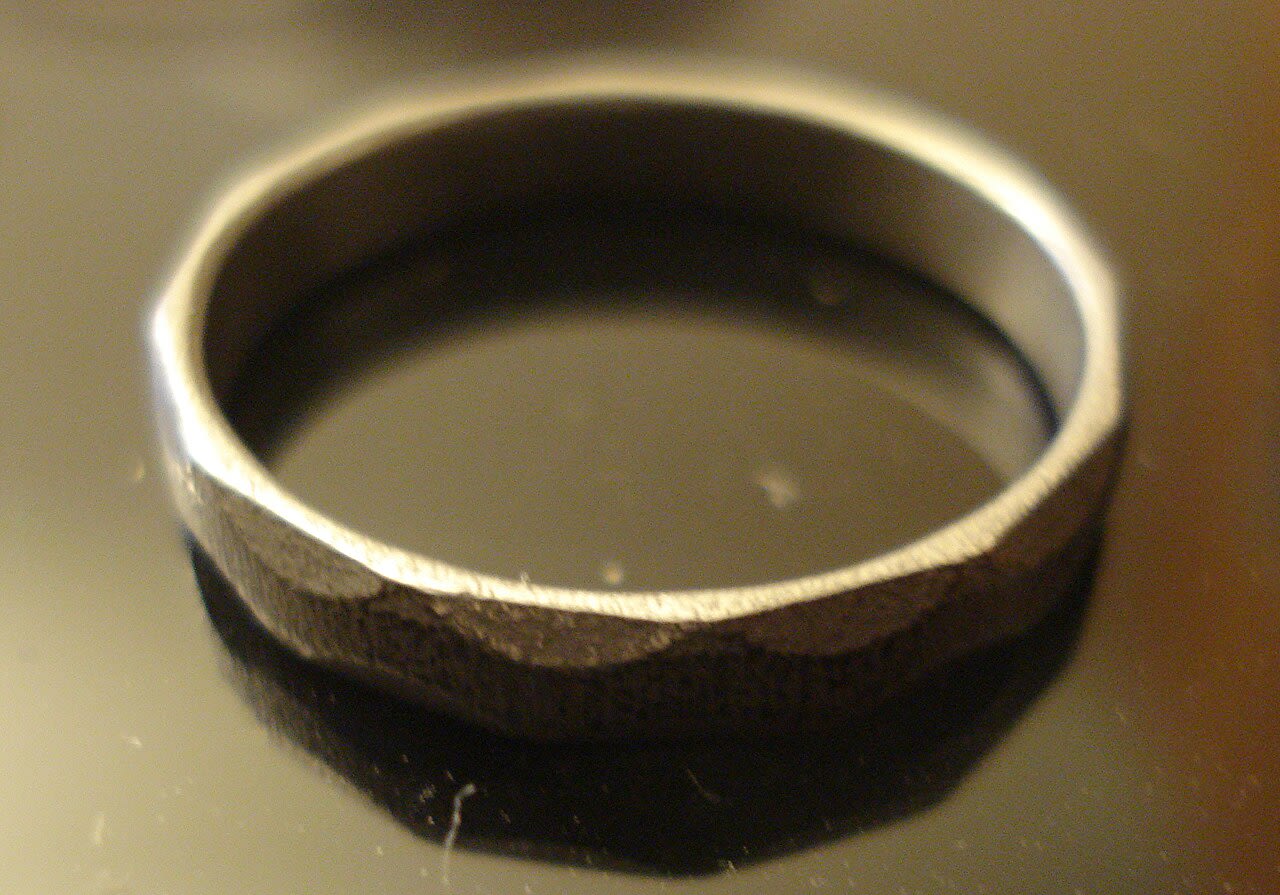
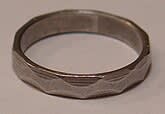
In Canada, engineers wear an iron ring on the little finger of their working hand, made from the remains of a bridge that collapsed catastrophically. a decent number of my engineer friends wear the ring.
-Jenn
Apparently not all engineers actually wear their rings, and these are only conferred to undergraduates. It has been commented that stainless steel is actually more common than iron, and that certain American universities have also started doing this.
I’ve used this successfully in practice once. It was the stainless steel one, pretty distinctive and smaller than I expected.
Black Ring on Middle Finger of Right Hand → Asexual
Source: Ana
Confidence: Mid, not confirmed
Background: https://en.wikipedia.org/wiki/LGBT_symbols
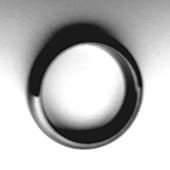
Apparently this is called an Ace ring.
Silver Ring with Gemstone / Engraving → Islamic Religion and/or Culture
Source: A friend (who was wearing one)
Confidence: High
Relevant Background: https://themuslimvibe.com/faith-islam/wearing-rings-and-gemstones-in-islam-philosophy-and-benefits
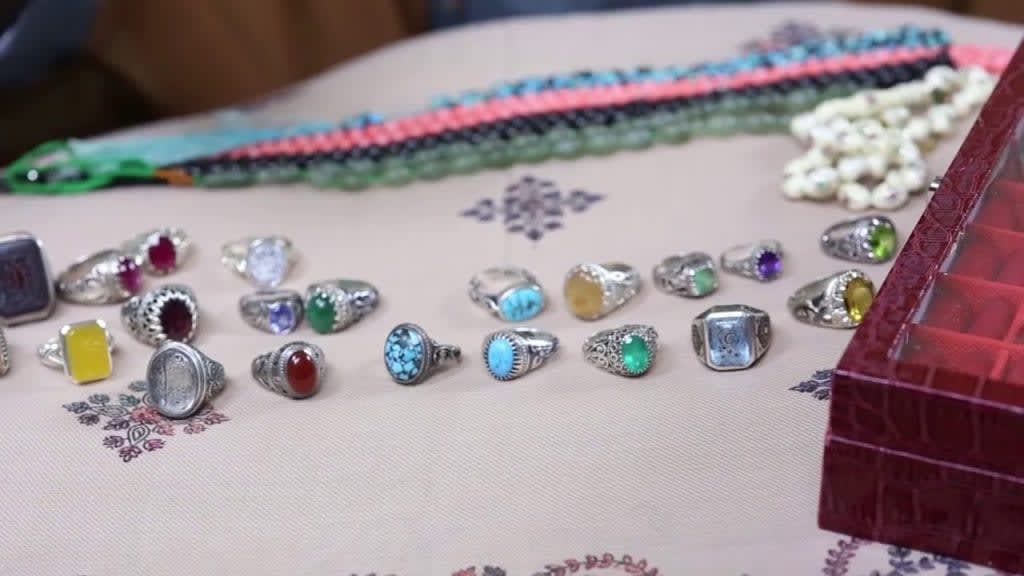
According to the source:
Most if not all Muslims agree that the Holy Prophet (pbuh) wore at least one ring, and this is something that is followed by Muslims all over the world.
As a result, it is so common for (male and female) Muslims to wear a ring that this is considered a sign of their religion. Gold is not permitted, but silver is widely permitted (brass and iron are more disputed). Sometimes rings have Arabic calligraphy (presumably the blockier Kufic script is common, as in other forms of Islamic jewelry). This usually seems to perform a religious function. There is not agreement on which hand the ring should be worn on, though it may be possible to guess more detailed information this way:
In Shia Islamic tradition, according to one narration, wearing a ring on the right hand is one of the signs of the believers
(Unfortunately it is not clear that this rules out other sects)
Gemstones are also common, particularly aqeeq (also called an agate). Depending on the color, gemstones are supposed to convey various benefits (apparently this is a superstitious function with religious elements).
Fingertip Marks → String Instruments
Source: Ana
Confidence: Mid
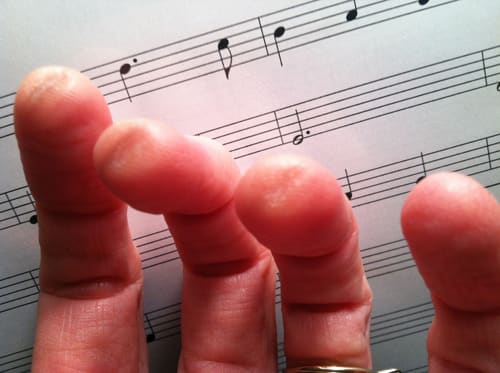
@Ms. Haze says this doesn’t usually happen under a normal level of practice, and my friend Gautier confirms that it can happen. Because this is consistent with the abduction I’ve claimed (though not its inverse implication) I’ve increases the confidence level from Low to Mid.
Also, according to @ndlxs:
More on stringed instrument players:
Callouses on left hand(fretting hand) fingertips(except the thumb). If left handed person, they may be on the right hand.
Fingernails cut short on fretting hand; for guitar players strumming/picking hand(opposite of fretting hand) fingernails may be longer for those who play fingerstyle guitar style.
@Brent confirms that short fingernails on one hand can indicate guitar playing.
I have found this remarkably hard to observe in practice, even while someone is actively playing guitar, mostly because people are always moving their hands.
Ridges on Nails → Sometimes Vitamin Deficiency, Damage, or Disease
Source: SeñorDingDong
Confidence: Low
Background: https://www.riverchasedermatology.com/blog/fingernail-ridges-what-causes-them/
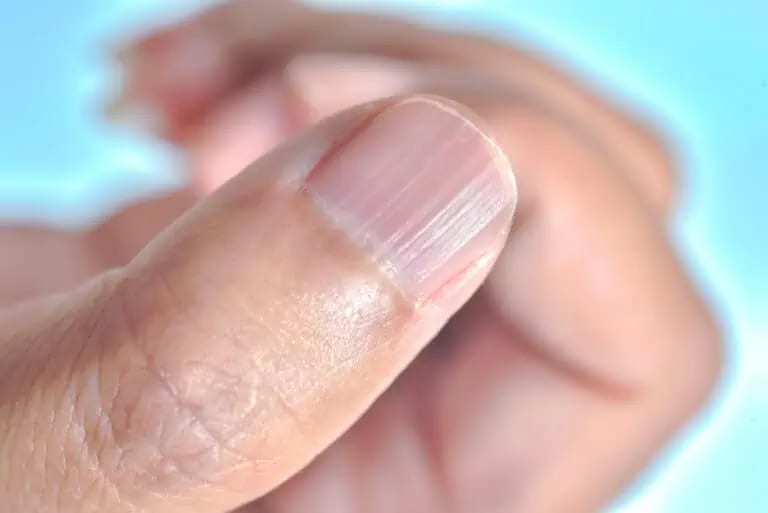
The vertical lines pictured in the top image occur in everyone to some degree, particularly with age, though they may be more distinct in cases of vitamin deficiency or as a result of some diseases. Horizontal lines (Beau lines) as pictured in the bottom image seem to be more rare and may result from interrupting growth by wearing fake nails or damaging the nails.
Fingertip discoloration → Smoker
Source: nicbeans311
Confidence: Low-Mid
Background: https://www.healthline.com/health/smoking/smoking-fingertips#what-it-looks-like
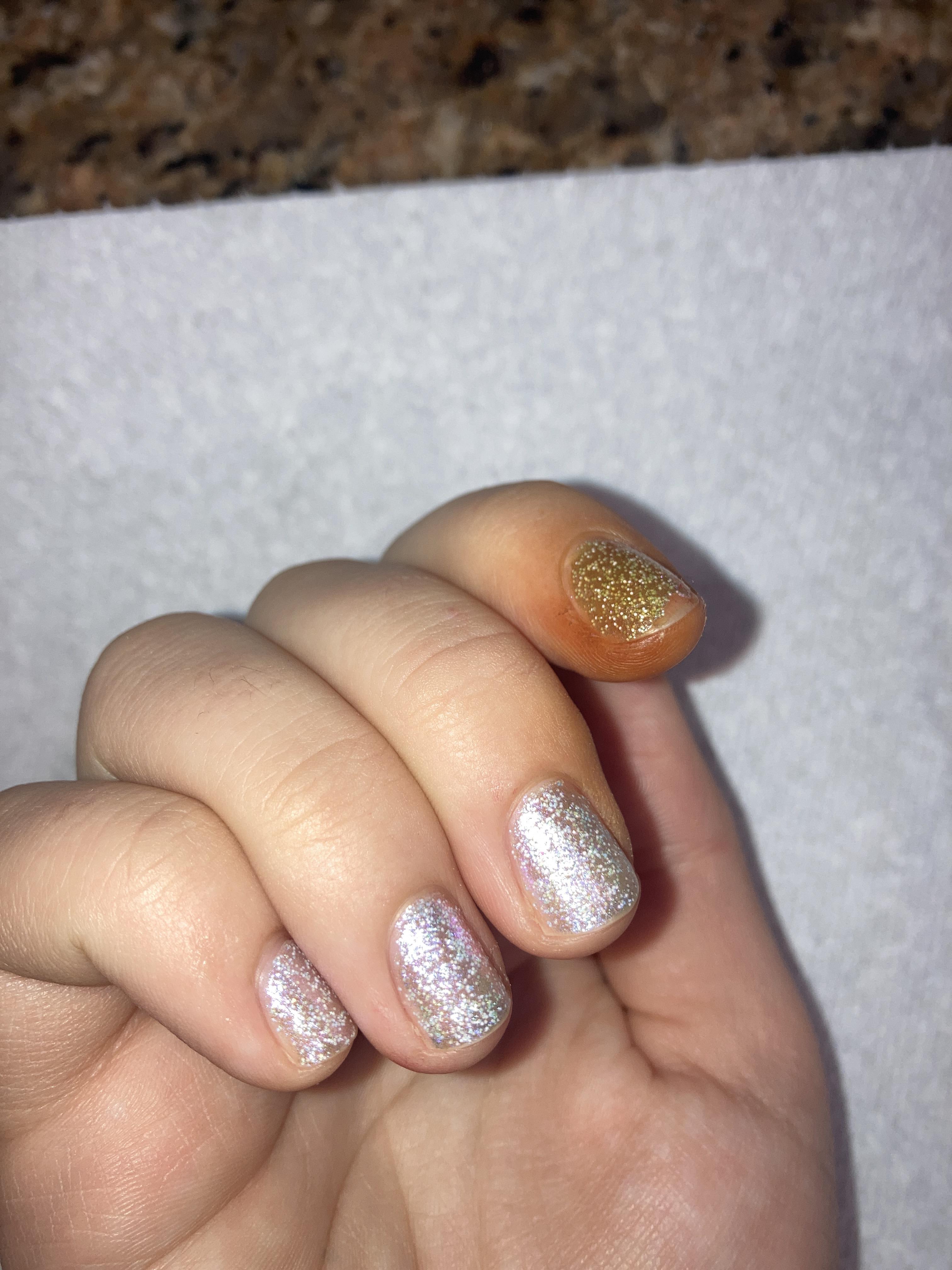
not so much now because of the increase in options and quality but years ago heavy marijuana users would have yellowish callouses on the thumb and pointer finger of their dominant hand. this is from breaking up the weed to evenly place into the rolling papers or blunt. the marks were also exacerbated by then smoking roaches down to the very last bit without a clip or holder.
Except for anecdotal claims, I haven’t been able to verify this as a sign of marijuana use specifically. However, it seems to be well-established that yellow-brown stains on thumb, index, and middle finger can result from cigarette smoking, and I certainly wouldn’t be surprised if weed caused similar effects.
Left-handed Finger-gun like “Wave” → Biker
Source: @jenn
Confidence: Mid
Background: https://www.gsmotorcycletours.com/post/motorcycle-nod-or-wave-the-facts

This seems to be most common on the road, but according to Jenn may be used under other circumstances (I haven’t directly verified this, but it tracks). It is a kind of solidarity gesture, 2 fingers (= index + middle) for 2 wheels on the road, and since it’s done in passing as pictured above it should always be the left hand.
Burnt Spoons/Ash Smudges → Opioid Use
Source: Anon
Confidence: Mid-High
Background: https://oasas.ny.gov/opioids (seriously this link is a treasure trove)

The link has an extensive list of signs of opioid use, including burnt spoons and bottle caps, and sleeves concealing track marks. In addition to these, apparently ash can get smudged on clothes/hands/face. Also if you notice belts or shoelaces going missing, this may be to cut off blood-flow during injection.
Slide bite → Firing a Handgun (probably a Glock)
Source: nicbeans311
Confidence: Low-Mid
Background: https://www.nrafamily.org/content/how-to-avoid-slide-bite/ A little more research indicates that guys with big hands using a glock often have trouble with this, so it may not be easy to avoid with good technique: https://www.reddit.com/r/Glocks/comments/m6x3h7/how_do_you_guys_deal_with_slide_bite/
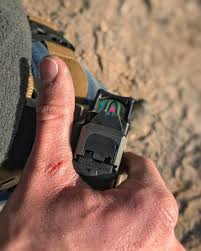
firing certain weapons can leave marks on a person’s hand. from slide bite from glocks to garand thumb from the m1 garand. there are also forearm marks from archery if you’re not wearing an arm guard.
a person also walks differently when wearing a weapon, their arm usually accommodates the space. a leather belt can show wear in the area where a badge might be repetitively attached and detached.
I’ve only fired a handgun on a few occasions—this never happened to me despite having terrible form, but that doesn’t say much one way or the other.
Garand Thumb → Firing an M1 Garand
Source: nicbeans311
Confidence: Low [SPECULATIVE]
Background: https://onwardresearch.com/garand-thumb/
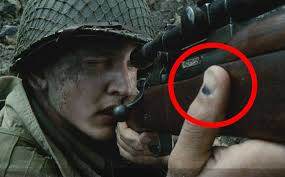
Note: The image above is NOT reliable, it’s pulled from a movie. I haven’t been able to find a useful confirmed image of garand thumb in real life (though this one is speculated to be real here). Please provide one if you have it, or comment on whether this one is realistic!
firing certain weapons can leave marks on a person’s hand. from slide bite from glocks to garand thumb from the m1 garand. there are also forearm marks from archery if you’re not wearing an arm guard.
a person also walks differently when wearing a weapon, their arm usually accommodates the space. a leather belt can show wear in the area where a badge might be repetitively attached and detached.
Awkward Gait (+ details) → Concealed Handgun
Source: nicbeans311
Confidence: Mid
Background: For a long list of signs indicating a concealed weapon, see https://coffeeordie.com/police-concealed-firearm-spot. For a scientific study validating changes to gait, see https://www.researchgate.net/publication/329928862_Human_Gait_Indicators_of_Carrying_a_Concealed_Firearm_A_Skeletal_Tracking_and_Data_Mining_Approach

a person also walks differently when wearing a weapon, their arm usually accommodates the space. a leather belt can show wear in the area where a badge might be repetitively attached and detached.
The first link contains a lot of helpful info from a police office (Sgt. Josh Cole). There is so much useful content that instead of copying it here I strongly suggest reading the entire thing yourself. The second is more technical, but seems to be saying that a person concealing a handgun at their right hip holds their right arm further from the body and higher (though Sgt. Cole suggests they may stabilize the gun by placing a hand on it, particularly when moving quickly) and their left arm closer and lower (not sure why, perhaps a side effect). Also, the right leg is extended a closer to the body (Sgt. Cole suggests shorter steps with the right leg—I have no idea if this is consistent, perhaps someone with knowledge of human anatomy can pitch in).
Abdominal Swelling → Portal Hypertension (Alcohol Use?)
Source: Ames
Confidence: Low
Background: https://www.highfocuscenters.com/does-alcohol-cause-bloating/, https://www.mayoclinic.org/diseases-conditions/alcoholic-hepatitis/symptoms-causes/syc-20351388, https://www.hopkinsmedicine.org/health/conditions-and-diseases/portal-hypertension
The pictured abdominal swelling looks a lot different than normal fat; it results from liver damage (check the third link for details from someone with actual medical credentials). This can be caused by alcohol abuse. Note (first link) that alcohol can also cause swelling and weight gain as well in the short term, which is a different matter. The second link contains more (often observable) symptoms of liver failure from alcohol, including jaundice (yellowing) of the skin.
Woman Rubbing or Resting Hands on Belly → Pregnant
Source: Novy
Confidence: Mid
Background: https://www.reddit.com/r/BabyBumps/comments/4aofuc/holding_resting_hands_on_or_rubbing_your_own_belly/, https://www.reddit.com/r/NewParents/comments/msmpof/anybody_else_finds_themselves_rocking_their_body/

Of course when a pregnancy is far along it’s obvious. However, it seems to be pretty common for women to frequently touch their bump for various reasons, including because of discomfort and to signal that it is pregnancy and not weight gain. This may be an early sign.
Also, apparently new parents tend to rock even when they aren’t carrying their baby! See the second link.
Birkin Bag → Wealthy and Status Obsessed
Source: Gennie
Confidence: Mid-High
Background: https://www.hermes.com/us/en/content/106191-birkin/
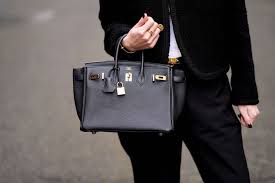
It’s impossible to just buy this bag from Hermes, you have to buy other items from them and play status games until they offer you the opportunity to buy a (specific) Birkin. If you say no you might not get another chance. Also, some Birkin’s are “better” than others. Typically they seem to run in the tens of thousands.
In general, it may be worth familiarizing yourself with the major high fashion brands. Though its certainly possible to waste too much time obsessing over these things, the leading “Fashion Houses” don’t seem to change very frequently and are a clear sign of either wealth or the desire to appear wealthy.
Burberry Pattern → Wealthy
Source: Gennie
Confidence: Mid
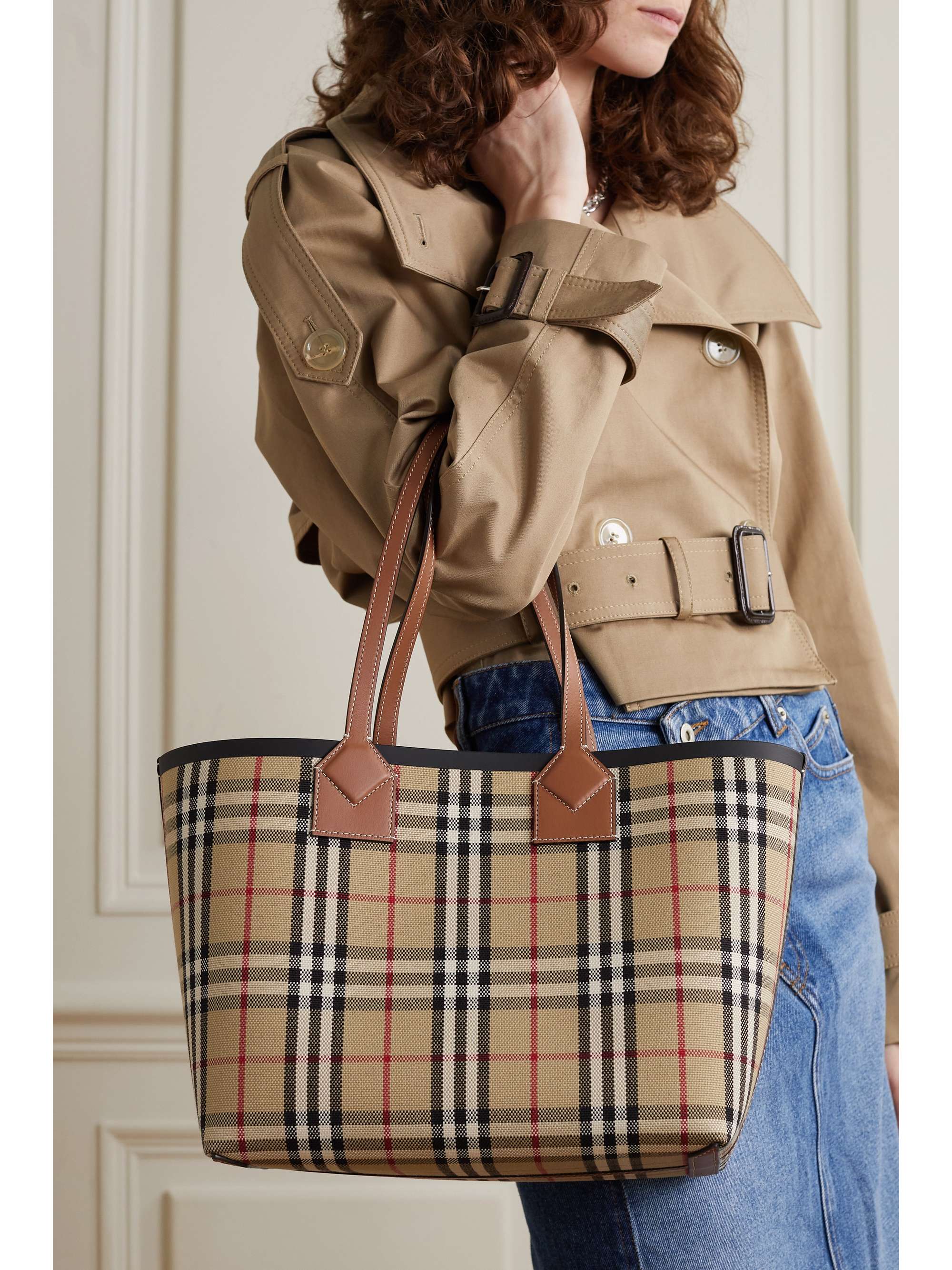
See the pattern on the bag. It appears on various items, which can be expected to run in the low thousands. A particularly obvious Burberry bag is framed as a blatant status symbol in Succession, as contrasted with the more “tasteful” aesthetic of “stealth wealth”.
Flagging → Gay (and, uh… details)
Source: @Ms. Haze
Confidence: Mid
Background: https://en.wikipedia.org/wiki/Handkerchief_code
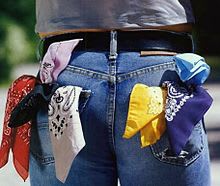
In-line with lace code is flagging, which has also mostly fallen out of use recently, and is not really done by gay youth these days, but you’ll still sometimes see it with older folks. Notably, to my knowledge, it has somewhat less geographic variation in colors than the lace code stuff does (though there still is some).
-Ms. Haze
Personally I don’t recommend clicking through that link too much, more details than one would want unless part of the subculture. Still, interesting to know all these handkerchiefs actually mean something instead of just being pretty.
Dust on Clothes → Working with or in Drywall / Paint / Concrete / Mud
Source: Ames
Confidence: Low-Mid
Background: https://www.reddit.com/r/Construction/comments/dnstgm/how_do_i_clean_cement_dust_from_clothes/

It’s often possible to narrow down a blue collar worker’s profession based on the dust/residue on their clothing, particularly work pants (the ones in the pictures are cement stains, perhaps from mixing concrete). Personally, I have a bit of trouble distinguishing the source (e.g. drywall v.s. concrete), but it’s probably obvious for anyone with direct experience. Ames summarizes the differences as follows:
Drywall dust is chalky
Paint is rubbery
Concrete is more dark
Mud is brown
Obviously, paint also comes in a lot of different colors.
Pants discoloration stains → Poolman / works with chlorine or bleach
Source: anonymous
Confidence: Mid
Relevant Background: https://www.quora.com/I-stained-my-purple-shirt-with-pure-chlorine-while-working-in-a-pool-Is-there-any-way-to-get-it-out
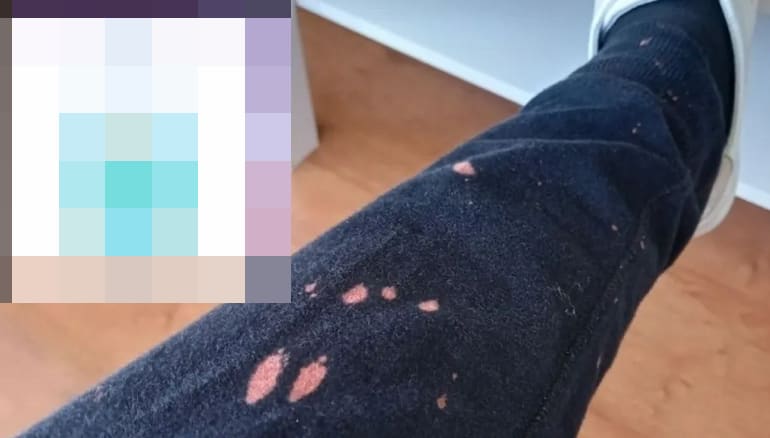
If you make the maintenance of a pool or work with bleach, you are gonna get this stains on the cloth, probably the pants because they are more closer to the floor/pool. In some countries the people clean the floor with bleach and water. You can also see this type of stains on people who bleach they hear, but probably the stains would be close to the head instead of the pants or cloth that is close to the floor.
The “relevant background” example provides some verification, but I have never attempted to use this in real life and there may be alternative explanations (in particular, I would not confidently conclude someone is specifically a poolman). Still, it’s nice to be able to distinguish bleach stains from concrete etc.
Braces → Cerebral Palsy
Source: @rationalelf
Confidence: Mid-High
Relevant Background: https://primecareprosthetics.com/blog/orthotics-for-cerebral-palsy-everything-you-need-to-know
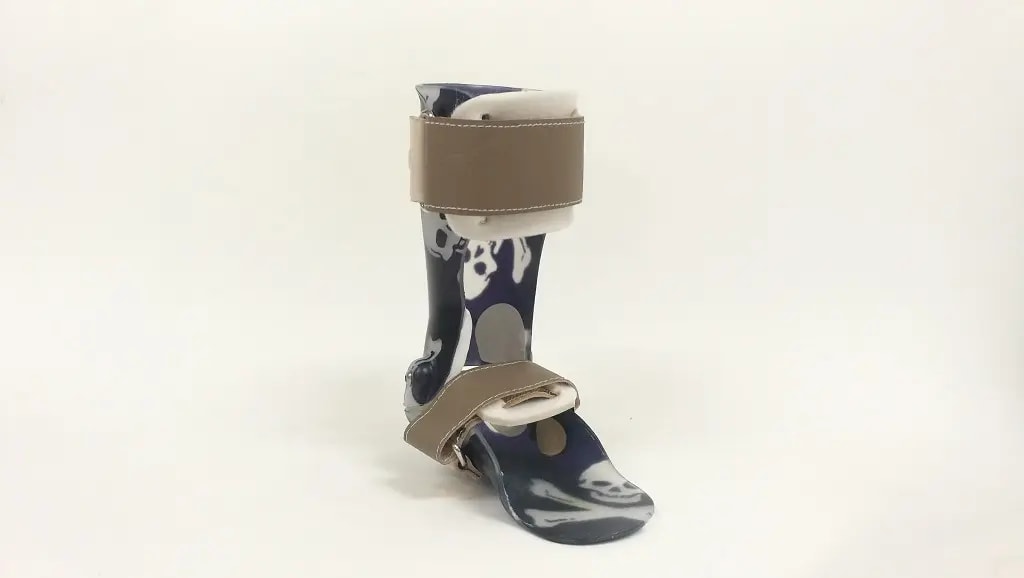
Of course, this type of brace (orthotics) should be distinguished from casts etc. Cerebral palsy is a neurological condition and is frequently (though not usually) accompanied by intellectual disability.
Chalk on Clothes → Climber (or sometimes Weight Lifter)
Source: Me (Cole Wyeth)
Confidence: Mid
Relevant Background: https://www.reddit.com/r/climbergirls/comments/1bakffd/is_this_an_excessive_amount_of_chalk_on_my/

Serious climbers typically use chalk to improve their grip for both indoor and outdoor climbing. I don’t use it much, but when I do it tends to get all over my clothes (and hands of course, but I’ll wash it off before leaving the gym). Of course weight lifters also use chalk sometimes—this is an alternative cause, but I weakly suspect its less likely for a weight lifter to get totally covered.
Climbers will also have relatively short fingernails (and probably also toenails because climbing shoes are tight). New climbers get callouses but this doesn’t happen much to me anymore. Neither of these get their own entry because they could imply many other things.
Right Pantleg Rolled up, Strapped, or Torn/Greasy → Bicyclist
Source: @whestler
Confidence: Mid-High

Rolled pants leg up to the ankle on the right hand side, but not the left—this is a fairly clear sign that someone is a cyclist, and has probably recently arrived.
They do it to avoid getting bike oil from the chain on the cuff of the pants, and to avoid the pants getting caught in the gear. Bicycles pretty much always have the crank gear on the right hand side.
Hole on Outer Edge of Shoe → Skateboarder
Source: @Kieren
Confidence: Mid
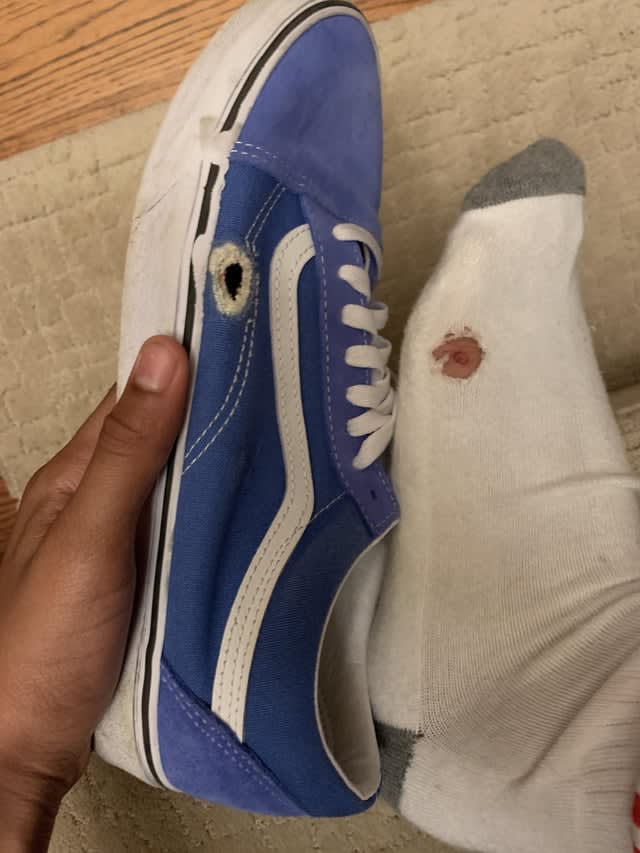
According to @Kieren:
Skateboarders will often suffer from an obvious ollie hole forming on the outer toe edge of their shoes. It comes from sliding your foot up the length of the board to level it out during an ollie. I’ve used the shoe glue repair technique depicted in this video before.
See the comment for more confirming details (banged up shins, tears on pants) - these seem less reliable to me since they likely have other potential causes.
Out-Toeing → Ballet Dancer
Source: Adriaan
Confidence: Low [SPECULATIVE]
It is a research-backed finding that ballet training affects gait, causing dancers to walk with their toes out, but I can’t rule out that other populations also exhibit out-toeing. In fact Adriaan himself walks this way without being a ballet dancer! Please let me know if you are aware of other causes.
Bump on Heel (Haglund’s Deformity) → Wearing Heels
Source: Me (Cole Wyeth)
Confidence: Low-Mid
Background: https://www.foothealthfacts.org/conditions/haglund%E2%80%99s-deformity
This bump is sometimes accompanied by redness/inflammation. It can also be caused by other hard backed shoes like ice skates and men’s dress shoes, but I think the rule should still be reasonably reliable at least when applied to women. Haglund’s deformity is common in ballet dancers.
Wearing heels often enough can also permanently bend the second, third, and fourth toes, counting from the big toe (see this article about ballet dancers). The condition is called hammertoe.
Lanvin Sneakers → Silicon Valley / Elite
Source: Me (Cole Wyeth)
Confidence: Mid
Background: https://www.businessinsider.com/silicon-valley-is-obsessed-with-lanvin-sneakers-2017-9

Lanvin sneakers seem to be the West Coast version of Louboutins below—a lot of tech CEO’s are apparently wearing them lately. Not sure how long this will last. They cost around $500 so a pretty expensive signal to send if you’re not wealthy.
Red Soled Heels → Upper Class / Elite
Source: Gennie
Confidence: Mid
Relevant Background: https://us.christianlouboutin.com/us_en/red-sole
Heels with a red sole are likely either a Louboutin or an imitation. This type of shoe costs somewhere in the high hundreds to low thousands. While this isn’t actually unattainable for the middle class, in my experience a Louboutin is only known as a status symbol among the upper class. These shoes once had an association with prostitution so may be too risque for “old money” families etc.
As an interesting note, Lydia wears Louboutins in Breaking Bad, symbolizing her concealed ruthlessness and responsibility for bloodshed.
Mesh Heels → Dancer
Source: Amanda
Confidence: Mid
Relevant Background: https://burjushoes.com/products/sierra?variant=48667908964662
According to my friend Amanda (who dances pretty competitively) this type of shoe is popular for a style of dance called “heels,” and is sometimes worn walking around. She hasn’t seen it on anyone who doesn’t dance.
List of Car Modifications → Used for Motorsports
Source: @Ruby
Confidence: High
Background: (see below)
This (great) entry has been allowed to stretch the ordinary format because Ruby provided several details that can indicate a “sporty” looking car is actually used for motorsports, and it seemed best to group them all together under a single heading:
Rare, but there are clear signs a car is used for actual motorsport and not just modified to look sporty/fashionable. You’ll see these on “dual duty” cars used both for sport and daily/street driving. (However, most cars used for motorsport are modified beyond either legal or practical street use and get trailered around. You’ll rarely see those.)
Tow hook (can also be a strap): makes it easy for the tow crew to pull your vehicle off track if necessary without wasting people’s time looking for an adequate place to hook.
Negative camber (the wheels are tilted). This is a crucial modification for taking corners at high speed. When cornering hard, the car will lean to outside, and cars with camber end up having the tire flatter to the road during the turn (more “contact patch” → “more grip”), but it comes at the cost of increased tire wear and reduced straight-line braking ability. Note that extreme camber is just a weird “fashion” thing and makes a car perform vastly worse).
Bucket seats with a harness. You install these so you stay in place even when experiencing high g-forces. Strong evidence of performance use if present, but more casual motorsport participants won’t install this in every car, especially more expensive luxury cars.
Performance tires also a sign of actual motorsport use of a car, but harder to discern without learning about tires. That said, tires often have a treadware rating printed on them and if you see 200, it’s a performance tire (but I’d be pretty sus of anyone who had 200tw tires but no camber). Well actually it’s not hard to see that a tire has minimal grooves/channels, and that’s a sign of performance tire as they improve dry grip at the expense of wet grip.
Small tech inspection stickers in the top corners of the windshield which might say something like “Audi Summer Driving Event 2024” or “OnGrid”. These are handed out to drivers at track events to signal their cars passed tech inspection. Extremely strong evidence. I recall one occasion of seeing this in the wild.
Many modifications are minimal or negative evidence about a car being used for performance driving (and by extension, the driver being particularly skilled). Things not meaning much:
- loud exhaust
- aftermarket wheels
- wing (spoiler)
- tinted windows
- lowered (very lowered cars (“slammed”) are evidence against as impractical and ruin suspension geometry)
- horsepower
- custom plates
At the end of the day, motorsport is a high-barrier-to-entry sport and 95+% of sporty-looking cars on the street will never be used for real sport.
If you ever see someone towing a sporty-looking car that’s in fine condition on a trailer behind an SUV, they’re likely going to or from the race track.
I’ve only spot-checked this content but it seems highly reliable.
Other Car Details
Source: NoCommunication7
Confidence: Low
Relevant Background: (See below)
I have not attempted to verify the below, and some seem dubious (for instance, a baby seat certainly does not imply marriage). Still, these seem worth looking for if you have the opportunity to examine a car up close.
Drivers side door handle, if there are scratches on the back of it or on the bodywork behind it, it’s a sign of possible marriage as it could be witness marks from a wedding ring
If there’s a baby seat in the back that’s a surefire sign of both marriage and a child
If there’s pinholes in the rear seat (if it’s a leather seat) it’s a sign of a dog owner
If the rear seat is covered, that’s also a sign of a dog owner trying to protect the rear seat from a dog
Chew marks are another sign of a dog, they often appear on things like locking tabs and baby seat anchor covers
Someone getting into a newer Rolls Royce, if they close the door by hand they are either not the owner or not familar with the vehicle (possibly a new owner), the doors on RR’s have an auto close button
Alternating field-like pattern in the carpet is a sign of a recent detail or valet
On pre-2009 jaguars you can get an idea of the driver or passengers fingernail lengths as the boot popper is the growler button, lots of scratches might be long finger nails
If there’s a haynes or other service manual on display, often means the owner does their own work, if it’s an older or lower end vehicle it also could mean the owner has fallen on hard times
Mismatched parts are an obvious sign of an accident, some are dead easy like mismatched doors and panels, but others are harder to spot, especially by casual observation, and professional accident repairs are basically impossible to spot
Calls a Drinking Fountain a “Bubbler” + American → From Wisconsin
Source: @Novy O’Connell
Confidence: Low-Mid
If someone uses the word “bubbler” instead of “water fountain” or “drinking fountain”, they are likely from Milwaukee or at least Wisconsin. I say this as a Wisconsinite who knows that many people outside of the state have not heard this way of referring to a water fountain. “Water fountain” and “drinking fountain” also have regional differences, but they both have widespread use across the United States, so this wouldn’t clue you into much. I’ve heard that Eastern Massachusetts also uses this terminology, but I have not been there so I cannot say from personal experience.
Also:
Along the same lines, if someone refers to a casserole as a “hot dish” (and especially if they have strong feelings about which term is correct) they are likely from Minnesota or North Dakota.
According to @Freyja:
I call a water fountain a bubbler and I’m from Australia
So this rule is only reliable within the U.S. This comment also caused me to lower the confidence. I think linguistic clues have a low bitrate and are not very reliable, but if you want more like this, see “Speaking American.”
Further Resources
Highly recommended list of common symbols: https://www.reddit.com/r/Symbology/comments/cts0nu/frequently_sought_symbols/
A list of modern “Hobo symbols” and their meanings: https://www.reddit.com/r/coolguides/comments/17f7h4d/a_cool_guide_to_modern_hobo_symbols/
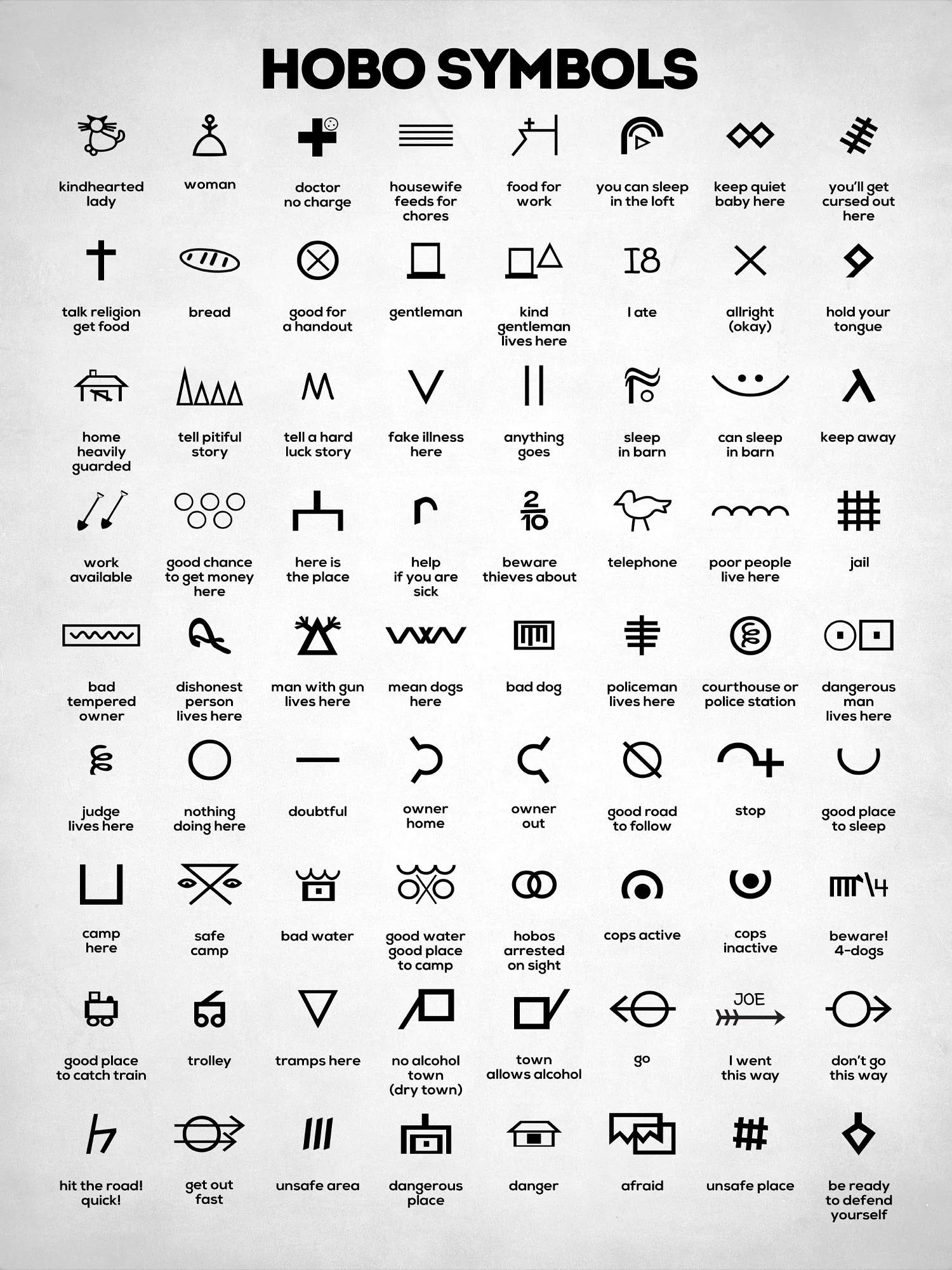
Takeaways
Generally, the easiest inference rules to find apply to people who are actively signaling something. For instance, designer brands are intended to signal status to those in the know (sometimes subtly), tattoos can intentionally convey messages (often about past trauma or to raise awareness for issues), and LGBTQ+ communities have historically used various codes to communicate membership. One might presume that other communities are still in “stealth mode” and haven’t shared their codes to this list—particularly if membership is highly taboo or if they have little intersection with the rationalist community. For instance, I don’t know how neo-Nazi’s currently identify each other (lace code is regional and outdated). Also, it is my impression that some people put minimal or zero effort into signaling unusual attributes through their appearance, which may mean they tend to be “inherently” inscrutable without access to superhuman perceptive abilities and fluid intelligence.
I am very interested in more sophisticated rules relying on gestures, posture, gait, or eye movement to conclude interesting facts, assuming they are reliable.
Working Notes
This section is temporary storage for suggestions that have not been researched or verified yet (but don’t appear as comments anywhere for me to refer back to). I recommend skipping it because it is not reliable info.
Do Catholics prefer the crucifix and Protestants the cross? https://www.reddit.com/r/Protestantism/comments/srtjtk/whats_so_wrong_with_the_crucifix/
Air Jordans? May be too obvious or not always imply anything.
Friendship bracelets → Taylor Swift fan
Kufic jewelry / Allah calligraphy → Middle Eastern Background:

Different fork / knife use in the U.K.
Traditional Croatian tattoos: https://en.wikipedia.org/wiki/Sicanje
33 as highest freemason degree: https://www.reddit.com/r/PeterExplainsTheJoke/comments/1ibc9gi/what_did_russell_brand_do_peter/
For the next phase, it will be necessary to conduct some interviews:
Talk to a symbologist if that is a real field of study and not something Dan Brown made up. I think maybe it’s called semiotics? https://www.reddit.com/r/Symbology/
Ask an optometrist about types of glasses
Ask a dermatologist about common and easily identifiable diseases
Perhaps talk to an expert on body language
- ^
A motif is basically a symbol that is reused in different forms across a line / collection.
- 's comment on Cole Wyeth’s Shortform by (25 Oct 2024 15:01 UTC; 3 points)
- 's comment on Cole Wyeth’s Shortform by (6 Oct 2024 20:14 UTC; 3 points)
- 's comment on Inverse Problems In Everyday Life by (9 Nov 2024 19:46 UTC; 2 points)
- 's comment on What are non-obvious class markers? by (29 Jul 2025 3:24 UTC; 2 points)


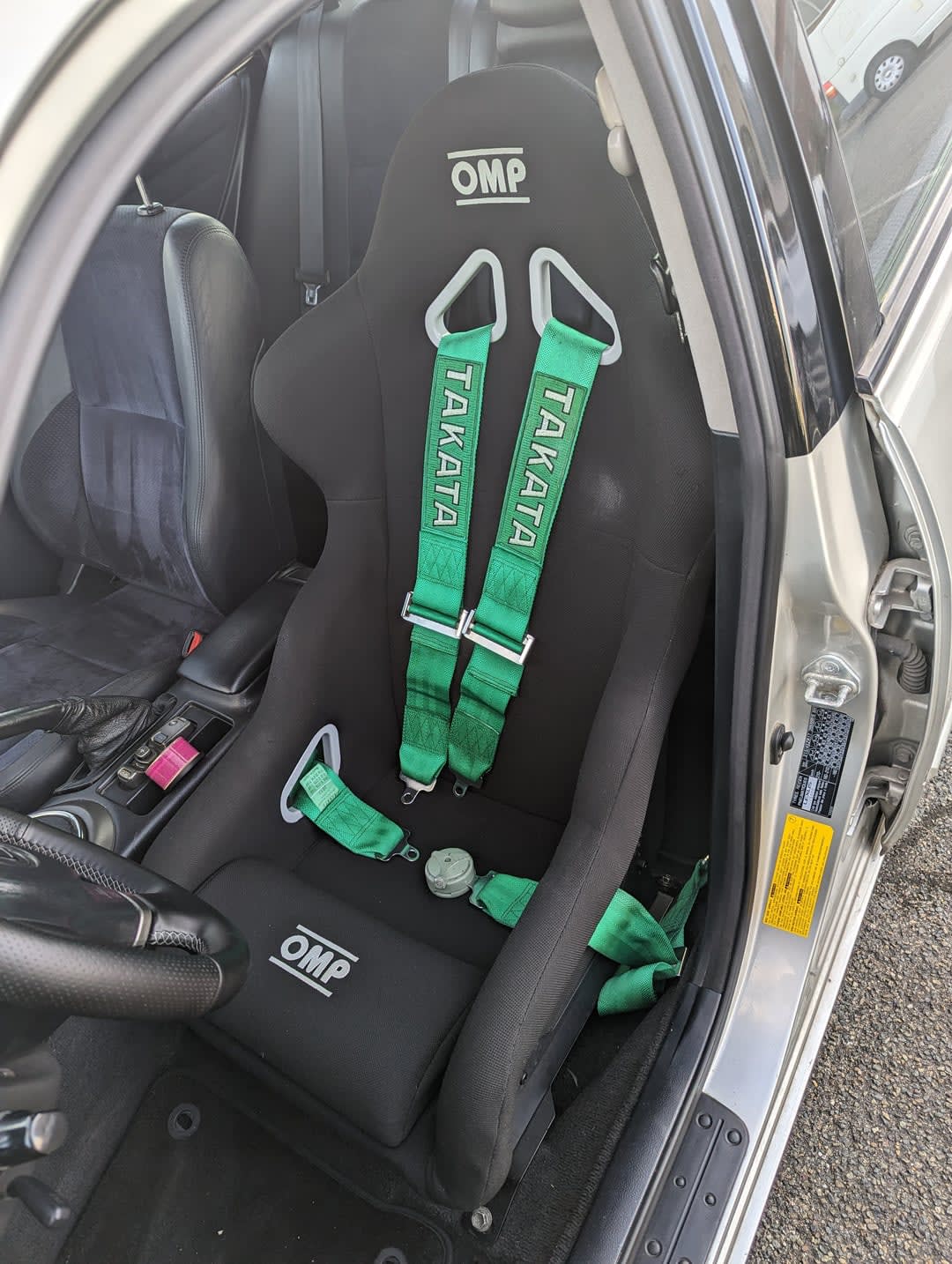
Rare, but there are clear signs a car is used for actual motorsport and not just modified to look sporty/fashionable. You’ll see these on “dual duty” cars used both for sport and daily/street driving. (However, most cars used for motorsport are modified beyond either legal or practical street use and get trailered around. You’ll rarely see those.)
Tow hook (can also be a strap): makes it easy for the tow crew to pull your vehicle off track if necessary without wasting people’s time looking for an adequate place to hook.
Negative camber (the wheels are tilted). This is a crucial modification for taking corners at high speed. When cornering hard, the car will lean to outside, and cars with camber end up having the tire flatter to the road during the turn (more “contact patch” → “more grip”), but it comes at the cost of increased tire wear and reduced straight-line braking ability. Note that extreme camber is just a weird “fashion” thing and makes a car perform vastly worse).
Bucket seats with a harness. You install these so you stay in place even when experiencing high g-forces. Strong evidence of performance use if present, but more casual motorsport participants won’t install this in every car, especially more expensive luxury cars.
Performance tires also a sign of actual motorsport use of a car, but harder to discern without learning about tires. That said, tires often have a treadware rating printed on them and if you see 200, it’s a performance tire (but I’d be pretty sus of anyone who had 200tw tires but no camber). Well actually it’s not hard to see that a tire has minimal grooves/channels, and that’s a sign of performance tire as they improve dry grip at the expense of wet grip.
Small tech inspection stickers in the top corners of the windshield which might say something like “Audi Summer Driving Event 2024” or “OnGrid”. These are handed out to drivers at track events to signal their cars passed tech inspection. Extremely strong evidence. I recall one occasion of seeing this in the wild.
Many modifications are minimal or negative evidence about a car being used for performance driving (and by extension, the driver being particularly skilled). Things not meaning much:
- loud exhaust
- aftermarket wheels
- wing (spoiler)
- tinted windows
- lowered (very lowered cars (“slammed”) are evidence against as impractical and ruin suspension geometry)
- horsepower
- custom plates
At the end of the day, motorsport is a high-barrier-to-entry sport and 95+% of sporty-looking cars on the street will never be used for real sport.
If you ever see someone towing a sporty-looking car that’s in fine condition on a trailer behind an SUV, they’re likely going to or from the race track.
Neat! This is the first submission that’s not discernible from meeting someone in person, so it almost has more of a Bourne/Wick feel than Holmes, but I think I’m here for it! Are there any signs that might remain on the person?
Hmm, on the person...if you knew what you were looking at, there’s swag (shirt/sweater/hat) that would be an indication. Anything saying “HPDE” (high performance driving event) would be a sign. I’m not sure if in higher levels there are characteristic ~injuries from repeated particular kinds of strain. There could be.
Certain driving habits would indicate a practiced driver even when not driving at speed, but hard to convey those subtleties in text.
leaving out obvious things like religious garb/religious symbols in jewlery, engagement rings/wedding bands, various pride flag colours and meanings etc:
semicolon tattoos: indicates that someone is struggling with or has overcome severe mental health challenges such as suicidal depression. You see them fairly often if you look for them. i’ve heard that butterflies and a few other tattoos mean similar things, but you’ll run into false positives with any more generic tattoos.
claddagh rings: learned about this while jewelry shopping recently; it’s a ring that looks like a pair of hands holding a heart. it’s an irish thing, the finger you wear it on and whether or not it’s inverted indicates your relationship status.
iron rings: In Canada, engineers wear an iron ring on the little finger of their working hand, made from the remains of a bridge that collapsed catastrophically. a decent number of my engineer friends wear the ring.
lace code: basically entirely dead, but if someone is dressed like a punk and they’re wearing black boots with red laces, there’s enough of a chance that they’re a nazi that i’d avoid them. there’s like a whole extended universe of lace colours and their meanings but red is the most (in)famous one.
astrology jewlery: astrology obviously isn’t real but if someone is wearing jewlery with their astrological sign, that tells you that 1) they are into astrology (or homestuck if you’re lucky) and 2) they likely have some affinity with their designated star sign, which you can ask them about.
teardrop tattoo right under the eye: this person killed someone or was in prison at some point, or want to pretend that that’s true for them (e.g. if they’re a soundcloud rapper from the suburbs). also see other prison tattoos
puzzle piece tattoo or jewelry: this person likely has an autistic child or close family member, and is not super up to date on the most uh, progressive thoughts on the topic. autistic people themselves are more likely to dislike the puzzle piece symbolism for autism
Oh, also it looks like you forgot to finish your sentence in the astrology section.
heh, thanks, I was going to make a joke about memorizing the top 10 astrology signs but then I didn’t think it was funny enough to actually complete
In-line with lace code is flagging, which has also mostly fallen out of use recently, and is not really done by gay youth these days, but you’ll still sometimes see it with older folks. Notably, to my knowledge, it has somewhat less geographic variation in colors than the lace code stuff does (though there still is some).
If someone accidentally uses “he” when they meant “she” or vice versa and when talking about a person who’s gender they know, it is likely because the speaker’s first language does not distinguish between he and she. This could be Finnish, Estonian, Hungarian and some Turkic languages and probably also other languages. I haven’t actually use it, but noticed it with a Finnish speaker.
Counterpoint: it could also be because the speaker thinks male is default and automatically thinks of an unknown person as male.
@Sune specified that they know the person’s gender.
Oh, yes, true. However, I still maintain that particularly jerkish people would be happy to misgender in that manner as they’d think that the only good gender is male or somesuch nonsense.
Retracting the comment because I have seen a couple of couterexamples, including myself!
Interesting! I will attempt to verify this and then add it to the list.
You didn’t quote Holmes!
Yeah that definitely belongs in the post :)
In the UK, I think the most common assumption for cauliflower ear would be playing rugby, rather than a combat sport.
No idea if that’s the statistically correct inference from seeing someone with the condition.
In what way is rugby wildly different from combat :-)
Yeah, I guess I view Rugby and American football as being essentially combat sports. This may be worth clarifying in the post, but no one who read it and then found out “oh this person actually did Rugby not wrestling” would be particularly surprised.
Still this is somewhat an illustration of the general problem, there are often many adjacent and some non-adjacent alternative explanations.
The conditional increase in probability for “participated in combat sports or something non-surprisingly adjacent” based on “has cauliflower ear” may not be anywhere near as large as you think. Even just among the people reading this post, you’ve got someone with a cauliflower ear (me) who got it by something completely unrelated (the ear freezing solid). How can you tell if the sample you used to derive your explanation is biased? From the post, it sounds like you’re into MMA more than is the average for the population. I would expect many things in your life therefore correlate with MMA just based on exposure, maybe completely spuriously, maybe just more strongly than is true for the population in general. If you’re excluding entire segments of the population from your sample, and I think you necessarily must do so in any non-trivial application of this technique, I don’t know how you could have confidence in the resulting explanation. At least not outside of very homogeneous populations.
Useful to have a counterexample.
No, I don’t think many other things in my life correlate with MMA. There are no other visual cues I would consider reliable.
If it’s not too personal, is your condition persistent? Does it include both ears? And does it look similar to what you might see on UFC fighters?
It is persistent (or at least has persisted for about 20 years), is just the one ear (because that was what was exposed), and could perhaps be differentiated from blunt trauma cases in that the swelling only affects the helix and the directionality is different. How to explain the last part? If you imagine an axis going down your ear canal, with blunt trauma the swelling is generally parallel to that axis (the ear is made thicker) while with my ear it’s along a radius perpendicular to that axis (the ear is made taller).
Thanks! Good to know.
Russell’s sign, a persistent cut or scar on the knuckles, indicates bulimia nervosa.
Anyone who uses the noun adjunct “Democrat” instead of the adjective “Democratic” is some flavor of right wing. (Obviously only applicable to America.)
I agree that in my experience this is definitely probabilistically biased in the direction you state, but I don’t think it’s consistently true. This usage varies.
In a similar vein, I have only ever seen the term “classical liberal” used by people who identify with the term.
This is true, but I’ve only ever heard people use it while describing their political views, and at that point, “Sherlockian Abduction” is unnecessary. My example is the kind of the thing people might slip into more casual conversation.
Similarly, American conservatives generally refer to democrats as “liberals” and rarely as “progressives,” which democrats use more often to describe themselves.
Conservatives do this, but so do leftists, so all you really learn is that they’re not a democrat. And even then, it’s not that strong evidence.
I think this is false. I have seen it regularly used to mean something like “particularly evil liberal.”
Being from America, I feel pretty confident seconding this one. I will be visiting America soon and pay attention for examples.
Presented this list and idea at a Socratica node:
Heavy chain necklaces are also popular, as are small heart-shaped padlocks, or even just ribbon chokers. There’s quite a bit of variety and personal expression here, making it challenging to read: typically the aim is either that other BDSM kinksters will figure it out and regular folks will assume it’s just fashion jewelry, or else that the wearer and their partner(s) know what it symbolizes and other people won’t. (Of course, sometimes it is just an edgy choice in fashion jewelry: on a teenager, the intended audience may be their parents and peers.) Much less often (in public) you’ll see entirely blatant versions like a steel or leather slave collar.
And to be more specific, this indicates a BDSM submissive, or possibly a switch. Dominants are likely to use other cues, such as wearing black leather, or different forms of jewelry.
This is fun (although endless, especially if we include things related to deliberate/semi-deliberate signalling), here are a few:
(1) Hobby-related examples. Callouses on the palm in the spot where fingers connect to hand (e.g. like weightlifting callouses) , and on the thumb (on the side facing towards the other fingers), is quite commonly due to rowing. E.g., the friction of the oar rotating around the fingers and thumb holding it. Crooked nose sometimes indicates repeated breaking—high contact sports or plain fighting most common. From experience, boxing is quite common due to the artificially frequent number of blows to the face. Can combine this with scars on the knuckles, or slightly puffy knuckles & poor motor control from repeated mini-fractures to indicate a serious fighter. But how useful is knowing someone’s hobby? Often they’ll just tell you right away…
(2) How about health conditions? This one is pretty useful and seems reasonably study-able (ofc not to become some unofficial doctor, just to make informed guesses). E.g., a CGM (Continuous Glucose Monitoring) in the arm for type-1 & II diabetics, ridges in the nails indicating possible zinc or iron deficiency, eye-bags for sleep deprivation; serious sun ageing on one side of the face for a possible long-haul driver; yellowing of skin for liver failure etc. And then all the obvious prosthetics, glasses, hearing aids, support dogs, dark glasses &c.
Notably, health conditions (if correctly diagnosed) often indicate lifestyle and occupation, and this is likely behind many of the observations of the real-life inspiration for Sherlock Holmes, surgeon Joseph Bell.
(3) Similarly what about nationality? Again, often informative and extremely useful in countries with...er… history. Paying attention to different accents would be a simple method, as would accumulating basic knowledge of geography and typical travel patterns. Knowing, for instance, that Russians travel to Turkey in large numbers, or Kurds to Nashville, means you could probably make pretty good guesses as to a person’s nationality even if you were not confident on different slavic/middle eastern languages.
(4) You mention clothing (red-bottomed shoes?) but this seems like a bottomless pit of data. You can gather lots of information from attire about: nationality (how easy is it to spot a tourist?) and religion (knowing the difference between the burkha, hijab, niqab, chador; happening to know most protestants rarely carry crosses on a chain; rastafarians; orthodox jews in various stages of training); occupation (looking at you, painter decorators); health (orthopedic shoes); class (in the UK traditionally, the flatcap, now, the shellsuit; quite a subtle exercise, and often region-dependent); age.
I suspect since the 19th century clothing is now less useful due to the slow breakdown of class and gender markers (and general trend towards bland causalwear internationally). The stratification and diversity of clothing was notably far more noticeable in Holmes’s time (as was, perhaps, national differences). Note how many of his deductions use general patterns from a ‘social role.’
Side-note: I am also not sure if I believe that learning more facts ‘pushes out’ others (the ‘cluttered mind’ idea), the main issue is opportunity cost. Watching lots of sitcoms hasn’t made it hard to learn new things because I can’t stop thinking of ‘the one where Ross murders a child’, but watcing tv was certainly time not-studying...
Thanks for all the suggestions—it will take some time to research and integrate them!
The task is effectively endless, there’s a tradeoff curve between time and insight → agency increases. I think that (particularly if a well-curated list of reliable rules is available) the average person should spend a few hours studying these matters a couple of times a decade to increase their agency. That means the list could still usefully be a little longer. The task of constructing and curating the list in the first place is more time consuming, which means I should be expected to spend more time than is strictly useful on it.
In terms of clothing, I included some well-established status symbols that seem to have staying power and linked to further resources for people who are interested—but I don’t recommend obsessively following the fashion cycle.
You’re probably right about the side-note, though it seems hard to disentangle.
I haven’t been able to verify that protestants don’t wear a cross on a chain—it seems like they prefer an empty cross to the more catholic-coded crucifix, but this doesn’t seem to be what you meant?
Skateboarders will often suffer from an obvious ollie hole forming on the outer toe edge of their shoes. It comes from sliding your foot up the length of the board to level it out during an ollie. I’ve used the shoe glue repair technique depicted in this video before.
Bruises and scratches on your shins and knees are a pretty good tell for when someone has been freestyle/street skating. You can tell this influencer skates besides from her username.
Less obvious tell are the roughed up sides of your jeans that comes from carrying your board around.
More on stringed instrument players:
Callouses on left hand(fretting hand) fingertips(except the thumb). If left handed person, they may be on the right hand.
Fingernails cut short on fretting hand; for guitar players strumming/picking hand(opposite of fretting hand) fingernails may be longer for those who play fingerstyle guitar style.
I can confirm seeing this one. I had a guitar teacher who had short nails on one hand, and long nails on the other.
re. the article saying it’s hard to observe; I think the short nails are pretty hard to spot (many people keep their nails short) but the long fingerstyle nails are quite unusual looking, though also not that common.
I suppose that’s right—long fingernails on exactly one hand could be easier to observe.
But overall I find the signs of string instruments very hard to notice. Hands are generally hard to observe because they’re usually in motion, often clasped or hidden (e.g. gloved) etc.
The Wikipedia link for claddagh rings goes to the Project Semicolon page.
Should be fixed.
my two cents on the fingertip marks thing: it definitely happens, but normal amounts of practice and play don’t generally cause them to last very long. if you see them, it’s very good evidence that the person plays a string instrument, but you’re not that likely to see them, so absence isn’t good evidence to the contrary.
Hi, I read the list and what about callous on hands.
I think that it is quite a popular sign to see among wheightlifters, bodybuilders and generally most people who seriously go to the gym.
I would give this a high confidence as long as the callouses are at the start of the fingers so on the palm of the hand technically right below the first knuckle.
Additionally if there are some callouses on the thumb that can indicate that they do olympic weightlifting meaning snatch and clean and jerk because there everybody uses a hook grip where the thumg is squeezed on to the bar by the other fingers to increase grip strength.
Generally I do think that from the callous you could also get to when they have last been there and with what intensity or weight they train. People on a higher level tend to have callous and rough skin already built up as far as I know, while people who are starting out or haven’t trained consistently with exercises that include pulling as those exercises are harder on the hands might have some but since it won’t be a mature cornea it is likely to fall of and be unsmooth.
The callouses are different from those that climbers get, as climbing and bouldering has a way bigger emphasis on the fingers so if the callous is also on the fingers on can conclude, that they climb.
If there are no callouses this doesn’t have to mean that they do not train as some people use lifting straps, but overall I have been able to observe it quite often with others but also when looking at my hands depending on if I was actively going to the gym or took a couple months break.
There might be other reasons for getting callous on the hands but I could not think of any that produce the same characteristics.
This is my first post so please be kind and let me know what you think
Thanks! I am particularly interested on the hook grip calluses on thumbs, I’ll look into that.
Calluses at the base of the finger (say, the knuckle-joint of the palm) are in my experience very difficult to classify. I get them there by climbing as you said, and though I also get some calluses on my fingers those tend to be less persistent and probably disappear most of the time (after climbing for awhile at my level of intensity I stop getting calluses). I have also seen them from biking—when I started out I used to look at people’s palms a lot and never came up with a reliable way to distinguish this from weightlifting. But if you could go into some more detail on the differences, perhaps I’ll add a more speculative entry and see how it stands up!
(If it’s your first post on lesswrong, welcome! I think you’ll find that kindness/politeness is the community norm here)
A confirmation sign here: it is rather common for lesbians to keep the fingernails of their dominant hand (at least, generally both) very short and carefully manicured (for, uh, reasons of comfort). There are of course many other women who also do this, for various reasons, so it’s not correlated enough to infer lesbianism from just short nails.
An edgy/high fashion, asymmetrical, shortish hairstyle is also suggestive. However, if she’s also wearing a tongue stud, that’s a pretty clear sign.
Rolled pants leg up to the ankle on the right hand side, but not the left—this is a fairly clear sign that someone is a cyclist, and has probably recently arrived.
They do it to avoid getting bike oil from the chain on the cuff of the pants, and to avoid the pants getting caught in the gear. Bicycles pretty much always have the crank gear on the right hand side.
Thanks, this is a nice one.
Similarly, bike clips on the bottoms of one or both trousers are also a dead giveaway.
A tatoo or jewelry of an astrological sign is a pretty strong indication that their birthday falls within the associated dates.
Also, Conan Doyle based Sherlock Holmes off of one of his university professors, who he claimed had the same observational abilities as Holmes.
Personally I would lower the Claddagh rings to :low. At Least in the northeast US every Irish girl I know wears one regardless of relationship status and doesn’t pay attention to the direction of it.
To add to it. Next time you are at a big clothing store check out the styles of pregnancy clothing. They have elastics around the tummy and often layers for nursing. They are pretty recognizable and a tell-tale sign someone is pregnant or postpartum. It’s not uncommon for women To wear pregnancy clothes for a while after the pregnancy as their body is still changing and it’s hard to change your wardrobe with a little one.
New parents are always swaying back and forth regardless of whether they are with kids. It’s funny once you see it.
Also: tripodding is something they tech you in EMT class as a telltale sign of respiratory distress. I shrugged it off in class but it’s pretty reliable. Sitting down, knees apart, with hands or elbows on knees.
I forget the brand. But they are clogs (not wood) that look a bit more modern. They are apparently good on the feet and primarily worn by nurses.
Okay, Claddagh rings have already been lowered once, I’ll kick them all the way down to Low [SPECULATIVE]. Thanks for the rest, I’ll take some time to research and integrate it—for a start, is this the clog?
https://www.amazon.ca/dp/B001EJMZ6S?ots=1&ascsubtag=%5Bartid%7C10055.g.43507106%5Bsrc%7Cwww.google.com%5Bch%7C%5Blt%7C%5Bpid%7C749b9f35-9e80-4755-be0c-ec3fcc47ef9f%5Baxid%7Cd8482e9e-0390-4043-9893-b3b76ee3c71b&linkCode=gg2&tag=goodhousekeeping_auto-append-20&th=1
Dansko! Thats the clog!
My uncle is a nurse and he named crocks and hoka. However all of these shoes, particularly the crocks, seem to have a similar look.
Crocks at least are waterproof and easily washable, which is obviously appealing for a nurse. On a older person it might indicate suffering from incontinence.
People who cut themselves with knives often have scar tissue that reflects that. Self-cutting often means that the person had depression in the past.
Some people peel skin of their fingers to deal with nervousness and that leaves marks. This habit can go in hand in hand with high anxiety/OCD.
Your ability to identify specific gait patterns in other people depends a lot on your ability to feel distinctions in how you move in your own body. If you don’t have trained body awareness I would expect most sophisticated rules to lead you astray.
There’s some tensing up in healthy people when they tell a lie. Given that there are plenty of reasons why someone might tense up that’s no good way to diagnose whether someone lies, but if you see someone who can lie without tensing up at all that is a sign of sociopathy. Sociopaths also have a lower startle response than healthy people.
I’ve noticed that some skydivers wear necklaces with a “closing pin.” Skydiving really is a lifestyle, and I don’t think that many people outside of skydiving would recognize a closing pin or wear it as jewelry.
This has got to be low frequency but is still a personal favorite thanks!
I call a water fountain a bubbler and I’m from Australia
Good to know, I’ll modify the confidence or perhaps change the statement—it seems that since the supporting data is a survey of Americans, it only justifies inferences about Americans.
Signs of Autism:
T-rex arms: walking around with arms at 90 degrees, sort of like they’re stuck after completing a task with them at this angle
Wearing earplugs or headphones: blocks out sound for those who are sensitive to loud noises, possibly true for some individuals with ADHD as well
Hand flapping: sometimes accompanied by jumping
Lining things up (ex. toys): lining toys up in a row or organizing them instead of actually playing with them is a pretty common sign of autism
Cole, great article and great quote there from the classic Conan Doyle’s A Study in Scarlet! Will add to my Goodreads favorite quotes list amongst the 12000 book collection hehe
If someone uses the word “bubbler” instead of “water fountain” or “drinking fountain”, they are likely from Milwaukee or at least Wisconsin. I say this as a Wisconsinite who knows that many people outside of the state have not heard this way of referring to a water fountain. “Water fountain” and “drinking fountain” also have regional differences, but they both have widespread use across the United States, so this wouldn’t clue you into much. I’ve heard that Eastern Massachusetts also uses this terminology, but I have not been there so I cannot say from personal experience.
Source: https://www.google.com/url?sa=i&url=https%3A%2F%2Fwww.reddit.com%2Fr%2FMapPorn%2Fcomments%2F9010e8%2Fwhat_do_you_call_that_thing_you_drink_water_from%2F&psig=AOvVaw29qVjSsJfLC6V_DU-fBKgg&ust=1720464567162000&source=images&cd=vfe&opi=89978449&ved=0CBEQjRxqFwoTCMjw0IzMlYcDFQAAAAAdAAAAABAE
Along the same lines, if someone refers to a casserole as a “hot dish” (and especially if they have strong feelings about which term is correct) they are likely from Minnesota or North Dakota.
Wanted to confirm. The map doesn’t show it well but Boston folks primarily call it a bubbler. Source: from Boston and it’s on this list of things people ask you to say
I think regionalisms are better approached systematically, as there are tons of scientific literature on this and even a Wikipedia article with an overview: https://en.wikipedia.org/wiki/American_English_regional_vocabulary (same for accents https://en.wikipedia.org/wiki/North_American_English_regional_phonology but that might require a fundamental study of English phonology)